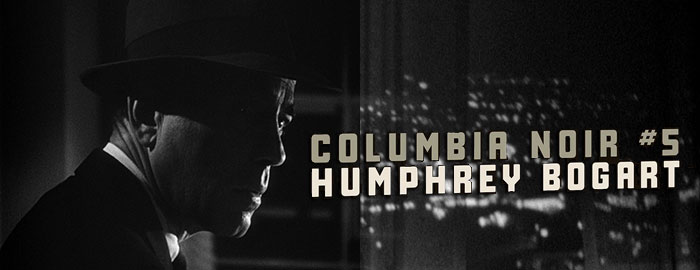
DEAD RECKONING
B&W, 1947, 100 mins. 29 secs.
Directed by John Cromwell
Starring Humphrey Bogart, Lizabeth Scott, Morris Carnovsky
Indicator (Blu-ray) (UK RB HD), Sony (DVD) (US R1 NTSC), Sidonis (Blu-ray & DVD) (France RB/R2 HD/PAL)
KNOCK ON ANY DOOR
B&W, 1949, 99 mins. 52 secs.
Directed by Nicholas Ray
Starring Humphrey Bogart, George Macready, Allene Roberts, John Derek, Candy Toxton
Indicator (Blu-ray) (UK RB HD), Sony (DVD) (US R1 NTSC), Sidonis (Blu-ray & DVD) (France RB/R2 HD/PAL)
TOKYO JOE
B&W, 1949, 88 mins. 31 secs.
Directed by Stuart Heisler
Starring Humphrey Bogart, Alexander Knox, Florence Marly, Teru Shimada
Indicator (Blu-ray) (UK RB HD), Sony (DVD) (US R0 NTSC), Sidonis (Blu-ray & DVD) (France RB/R2 HD/PAL)
SIROCCO
Color, 1951, 98 mins. 20 secs.
Directed by Charles Bernhardt
Starring Humphrey Bogart, Märta Torén, Lee J. Cobb
Indicator (Blu-ray) (UK RB HD), Sony (DVD) (US R1 NTSC)
THE FAMILY SECRET
B&W, 1951, 84 mins. 54 secs.
Directed by Henry Levin
Starring John Derek, Lee J. Cobb, Jody Lawrance, Erin O'Brien-Moore
Indicator (Blu-ray) (UK RB HD), Sony (DVD-R) (US R0 NTSC)
THE HARDER THEY FALL
B&W, 1956, 108 mins. 46 secs.
Directed by Mark Robson
Starring Humphrey Bogart, Rod Steiger, Jan Sterling, Mike Lane, Max Baer
Indicator (Blu-ray) (UK RB HD), Sony (DVD) (US R1 NTSC), Sidonis (Blu-ray & DVD) (France RB/R2 HD/PAL) / WS (1.85:1) (16:9)
It took a little while for 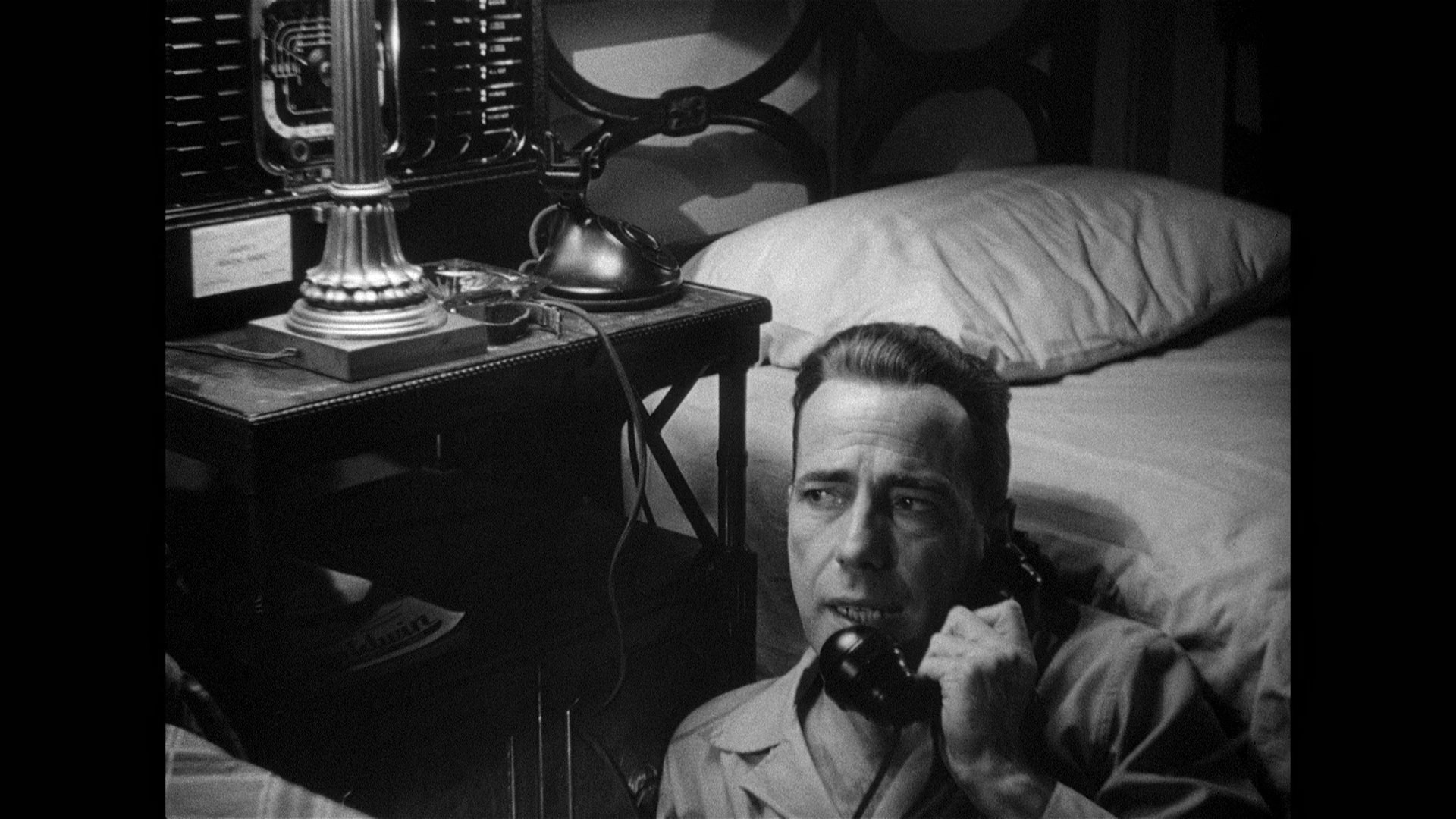 Indicator to jump back into the waters of its Columbia postwar film noir releases, which began
Indicator to jump back into the waters of its Columbia postwar film noir releases, which began 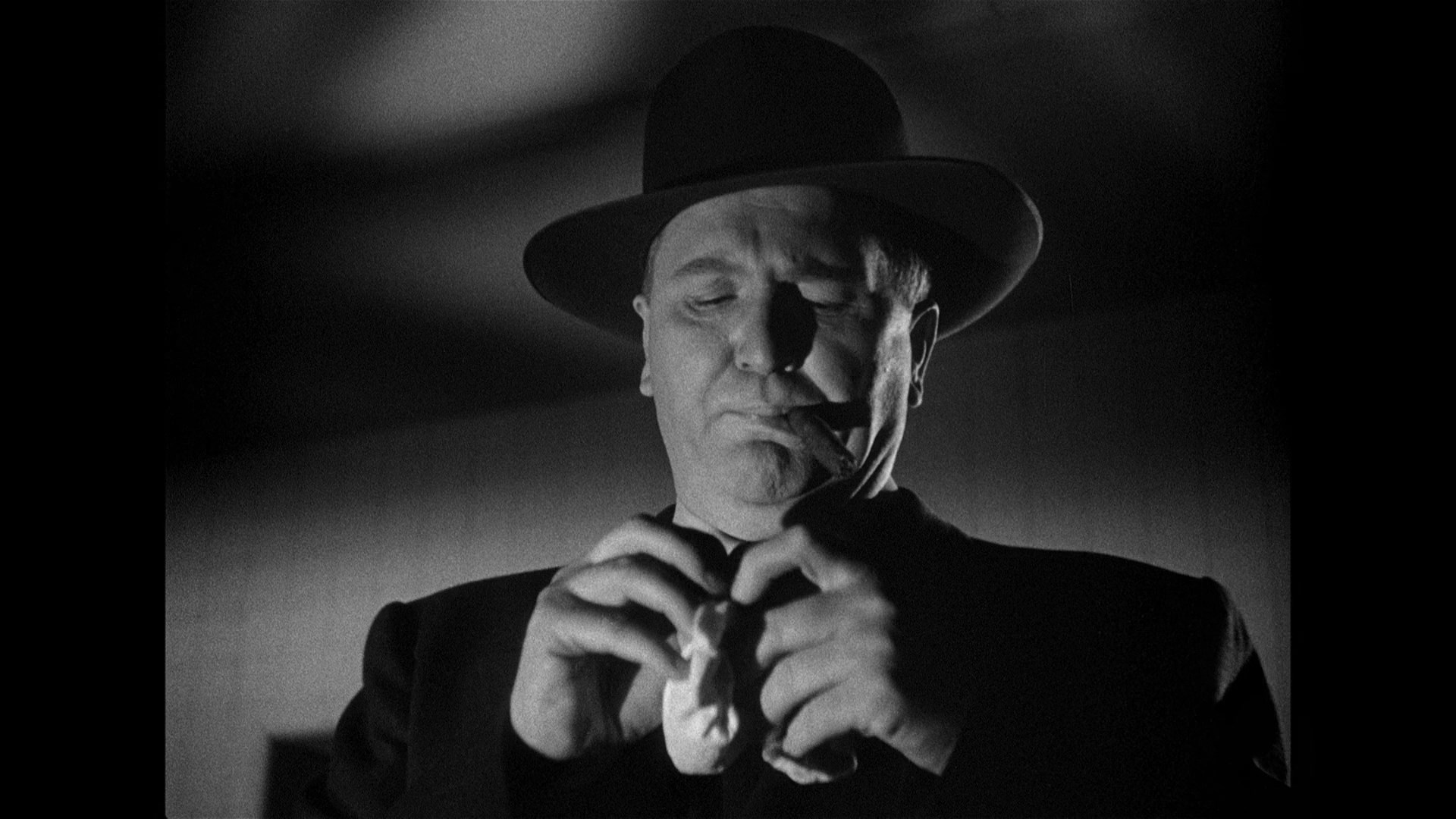 with Columbia Noir #1 and kept going with Columbia Noir #2, Columbia Noir #3, and Columbia Noir #4. This time they go for a more unified series with the limited 6,000-unit Columbia Noir #5: Humphrey Bogart, encompassing a nine-year stretch for the beloved leading man at Columbia (leading up to right before his death) in the wake of his beloved hits like The Maltese Falcon, The Big Sleep, and Casablanca. Most of these have been widely available on home video before but look fantastic here, with one significant rarity added from Bogart's work as a producer rather than an actor. It also serves as a kind of spotlight for Bogart's own Santana Productions and its stable of actors including a young John Derek, long before he went on to notoriety focusing on his wife, Bo. As usual the definition of noir gets stretched a lot here with multiple titles really classified more accurately as straight-up melodramas, but it's great to have them in HD all the same with the usual bounty of substantial bonus features.
with Columbia Noir #1 and kept going with Columbia Noir #2, Columbia Noir #3, and Columbia Noir #4. This time they go for a more unified series with the limited 6,000-unit Columbia Noir #5: Humphrey Bogart, encompassing a nine-year stretch for the beloved leading man at Columbia (leading up to right before his death) in the wake of his beloved hits like The Maltese Falcon, The Big Sleep, and Casablanca. Most of these have been widely available on home video before but look fantastic here, with one significant rarity added from Bogart's work as a producer rather than an actor. It also serves as a kind of spotlight for Bogart's own Santana Productions and its stable of actors including a young John Derek, long before he went on to notoriety focusing on his wife, Bo. As usual the definition of noir gets stretched a lot here with multiple titles really classified more accurately as straight-up melodramas, but it's great to have them in HD all the same with the usual bounty of substantial bonus features.
First up is 1947's Dead Reckoning, a true blue noir featuring one of its icons, Lizabeth Scott, who also headlined Too Late for Tears and Desert Fury. Here we get the story of Captain Rip Murdock (Bogart), who's given an order to take a train trip with his buddy Johnny to go to Washington D.C. for a Medal of Honor presentation. However, Johnny seems very averse to have his photo taken and disappears, seemingly turning up dead soon after. Rip follows a trail to find out that his friend was actually serving in the military under an assumed name following a homicide charge, and the victim's wife, Coral (Scott), may have been the cause of it all. Rip starts to fall for Coral, setting into motion a chain of twisty events where nothing is what it seems. Slathered in hardboiled Southern narration by Bogart, this is one of the more stylish mid-career films from director John Cromwell who had already done films like Algiers, The Enchanted Cottage, and Anna and the King of Siam. Though this will never be ranked in the pantheon of A-list noir classics, Dead Reckoning is an entertaining checklist of  noir tropes delivering with gritty panache and anchored by a typically solid performance by Bogart
noir tropes delivering with gritty panache and anchored by a typically solid performance by Bogart 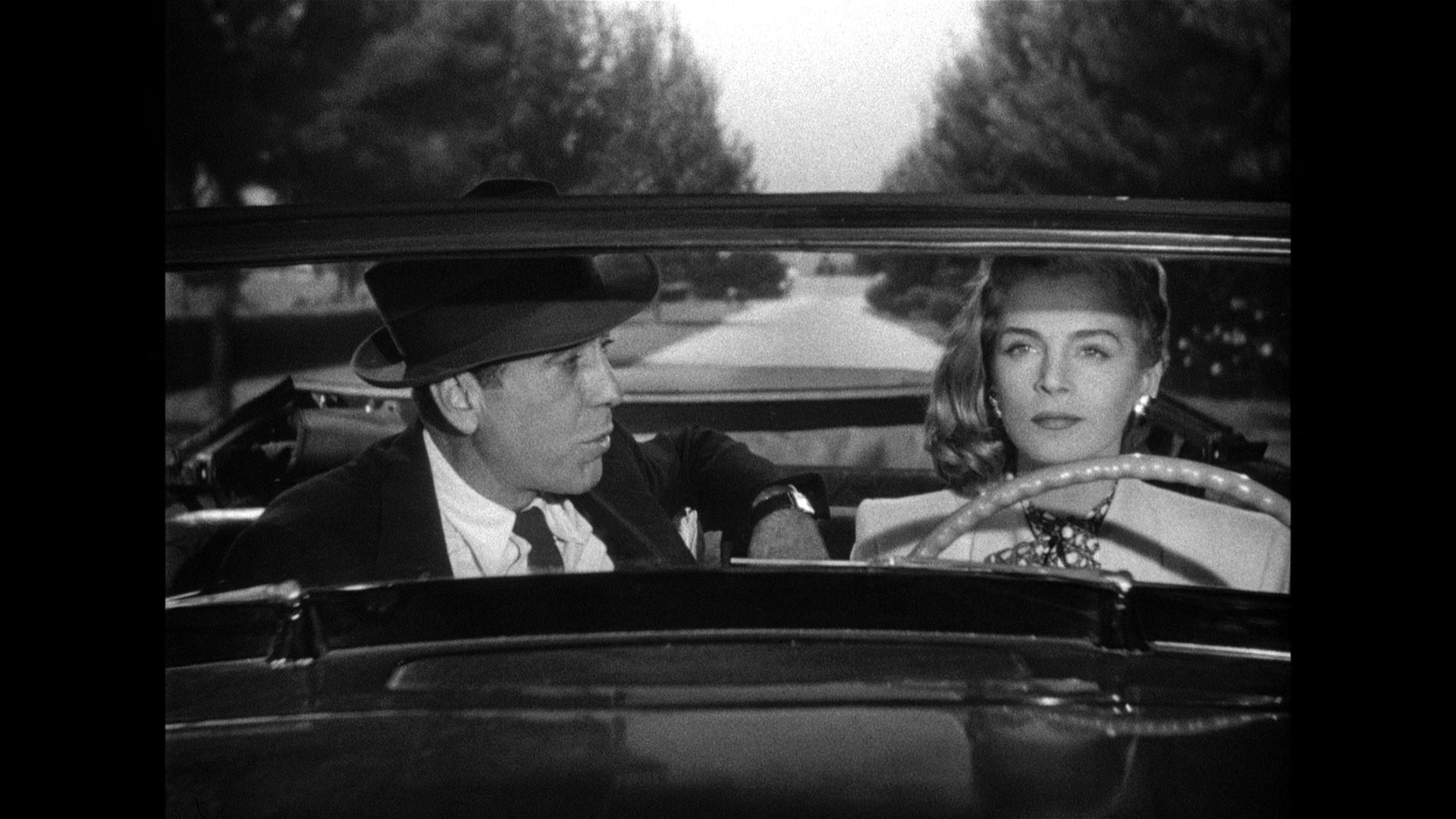 doing what he does best.
doing what he does best.
Widely available on VHS in the late '80s and '90s at just about every video store on the planet, Dead Reckoning hit Blu-ray in a no-frills edition in 2002 with a French combo Blu-ray and DVD edition following in 2018. The Indicator release comes from the same HD master prepped by Sony and looks excellent for the most part with fine detail; the source is mostly in great shape apart from a handful of visible hairline scratches (most visibly during Bogart's interrogation at a nightclub bar). As with the subsequent titles in this set, the LPCM English 1.0 mono track is in great shape and features improved English SDH subtitles. An informative and thorough new commentary by Alan K. Rode covers the nuts and bolts of the production including Scott's annoyance at being wedged into the film when Rita Hayworth proved unavailable, some issues with Cromwell's directing style, Bogart's career at the time, and much more. In "A Pretty Good Shot' (16m37s), Tony Rayns offers a thumbnail history of the film's path at Columbia and the merits of the end result as a "good, generic noir." The Cromwell-directed Watchtower Over Tomorrow (1945, 15m45s) is a short documentary snapshot of the formation of the United Nations after World War II-- though it's perhaps most interesting as a broader time capsule of the worldwide push for peace that didn't quite pan out as planned in the long run. Finally the disc wraps with a 79-image gallery featuring a slew of promotional and production shots.
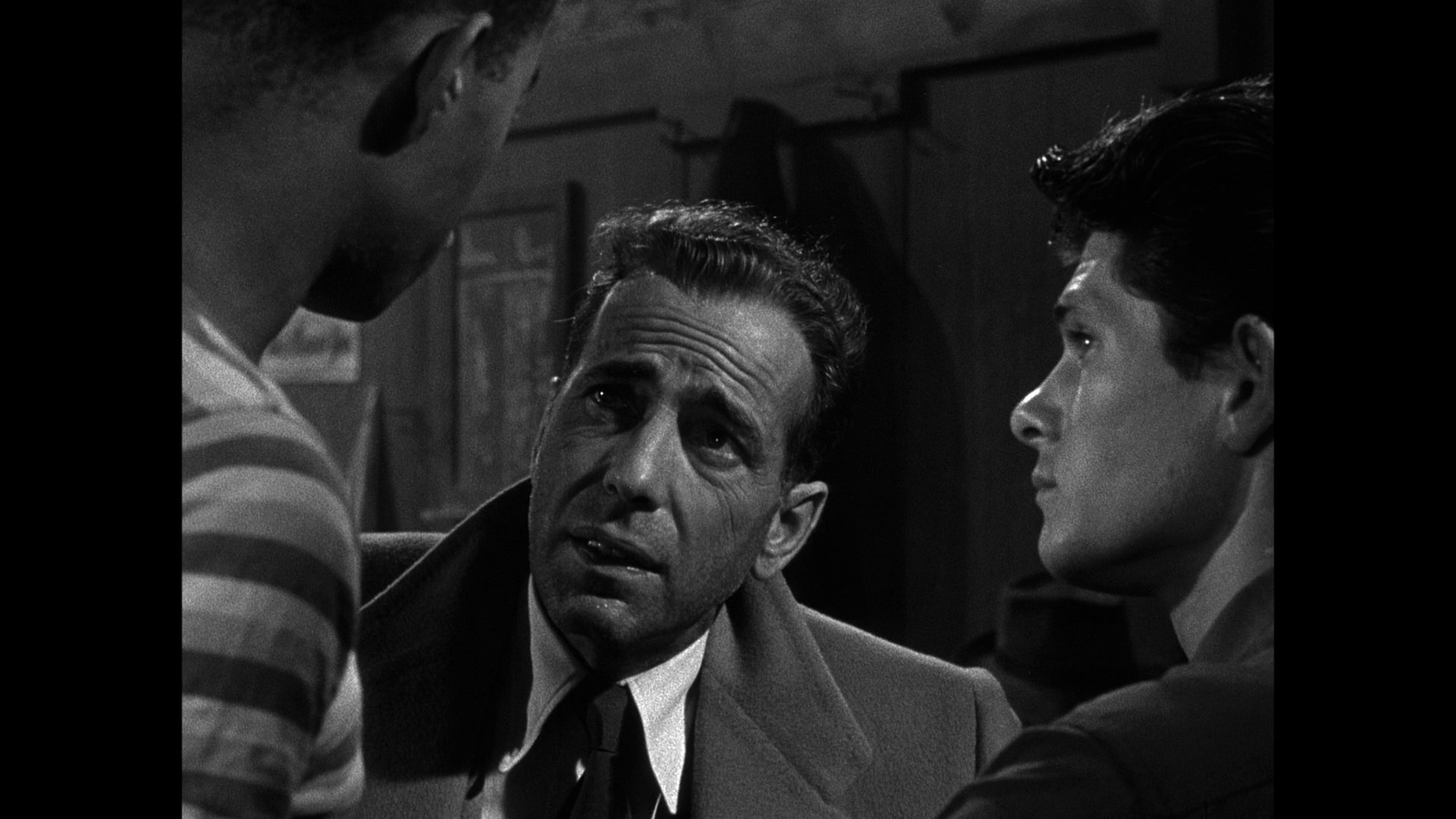 Next we skip ahead two years for Knock on Any Door, best known today as the second
Next we skip ahead two years for Knock on Any Door, best known today as the second 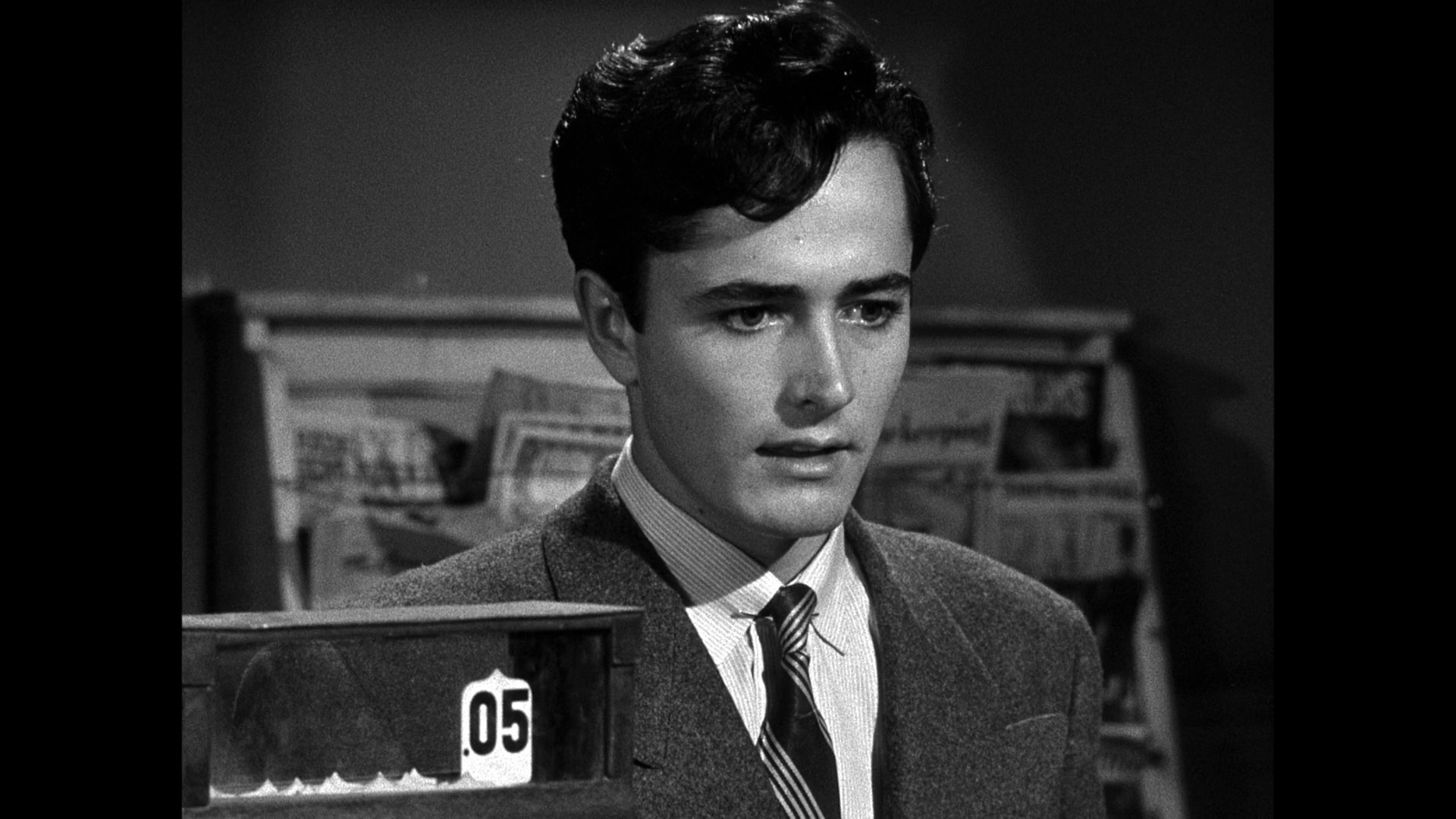 (or third, depending how you're counting) film directed by Nicholas Ray (who would reteam with Bogart more famously again with In a Lonely Place). Essentially a combination of troubled youth drama and courtroom thriller, this film (the first in the set from Bogart's Santana Productions but far from the last) was quickly adapted from a bestselling 1947 novel by Willard Motley with Derek enthusiastically approaching Bogart and company for what would be his feature film debut. In Chicago's skid row, slum kid Nick Romano (Derek) is nabbed by the police for the shooting death of an officer late at night. Still feeling guilty over his botched defense of Nick's dad, attorney Andrew Morton (Bogart) is goaded by his wife (Coxton) into defending Nick whom he believes is an innocent production of society's ills. Nick's famous motto, "Live fast, die young, and have a good-looking corpse," is dramatized in flashbacks as we see him bouncing through a challenging life that seems to always force him to turn to crime, which culminates in the trial that will determine his life or death.
(or third, depending how you're counting) film directed by Nicholas Ray (who would reteam with Bogart more famously again with In a Lonely Place). Essentially a combination of troubled youth drama and courtroom thriller, this film (the first in the set from Bogart's Santana Productions but far from the last) was quickly adapted from a bestselling 1947 novel by Willard Motley with Derek enthusiastically approaching Bogart and company for what would be his feature film debut. In Chicago's skid row, slum kid Nick Romano (Derek) is nabbed by the police for the shooting death of an officer late at night. Still feeling guilty over his botched defense of Nick's dad, attorney Andrew Morton (Bogart) is goaded by his wife (Coxton) into defending Nick whom he believes is an innocent production of society's ills. Nick's famous motto, "Live fast, die young, and have a good-looking corpse," is dramatized in flashbacks as we see him bouncing through a challenging life that seems to always force him to turn to crime, which culminates in the trial that will determine his life or death.
Predating the juvenile delinquent film wave that would become inescapable in the 1950s (especially Ray's most famous film, Rebel without a Cause), Knock on Any Door is really a better showcase for Bogart than Derek, with the latter touted as a hot new star and likely teen heartthrob at the time. This would ultimately be his most respected role with Derek mostly stuck in bland throwaway parts after this apart from his rather fetish-y turn in The Ten Commandments, but he holds his own well enough including some nice flashback moments 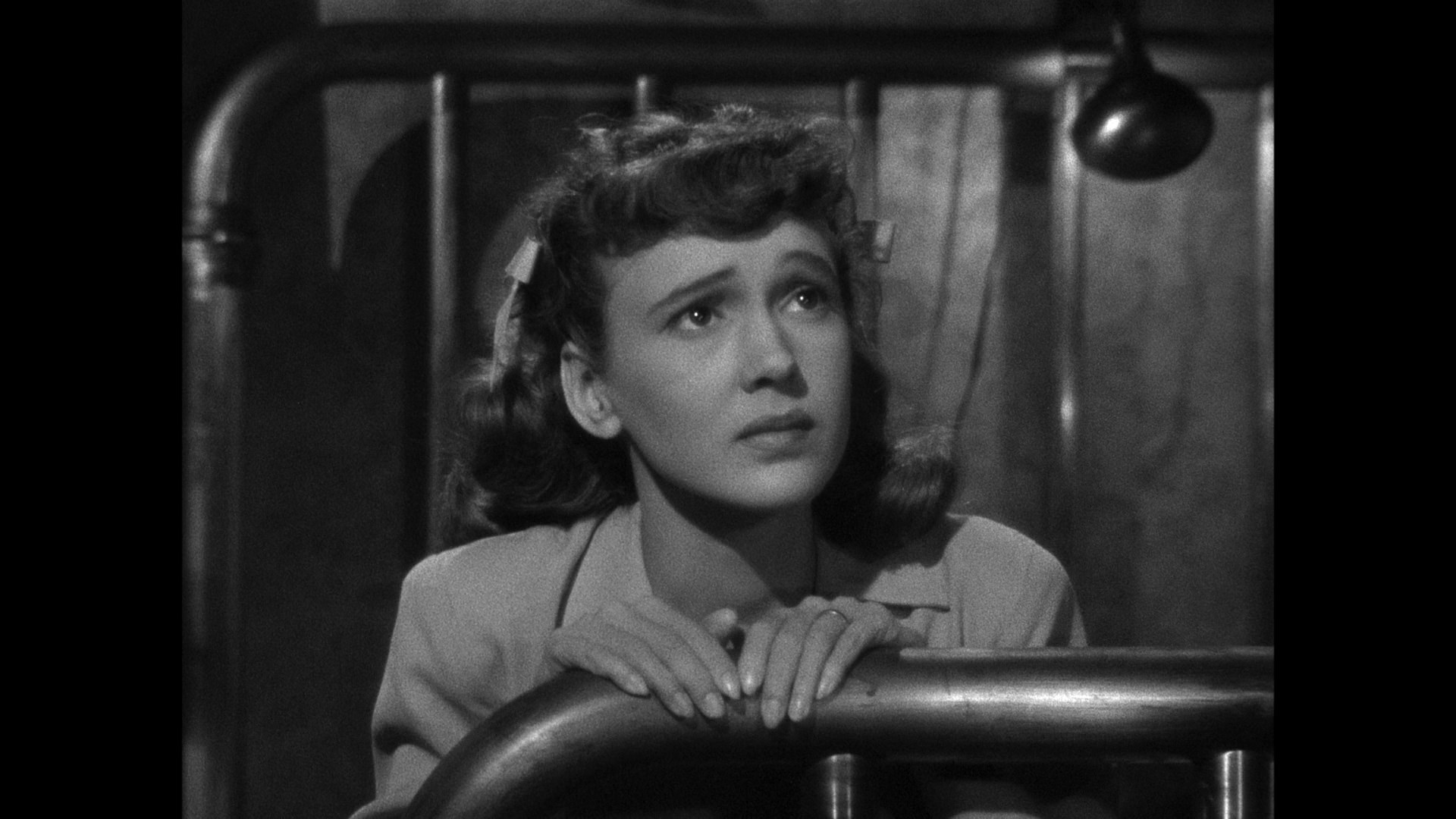 demonstrating the motivations behind his illegal behavior. Any film that lets Bogart monologue is obviously going to be worth a look, and this one really delivers especially in the courtroom scenes with Bogart's
demonstrating the motivations behind his illegal behavior. Any film that lets Bogart monologue is obviously going to be worth a look, and this one really delivers especially in the courtroom scenes with Bogart's 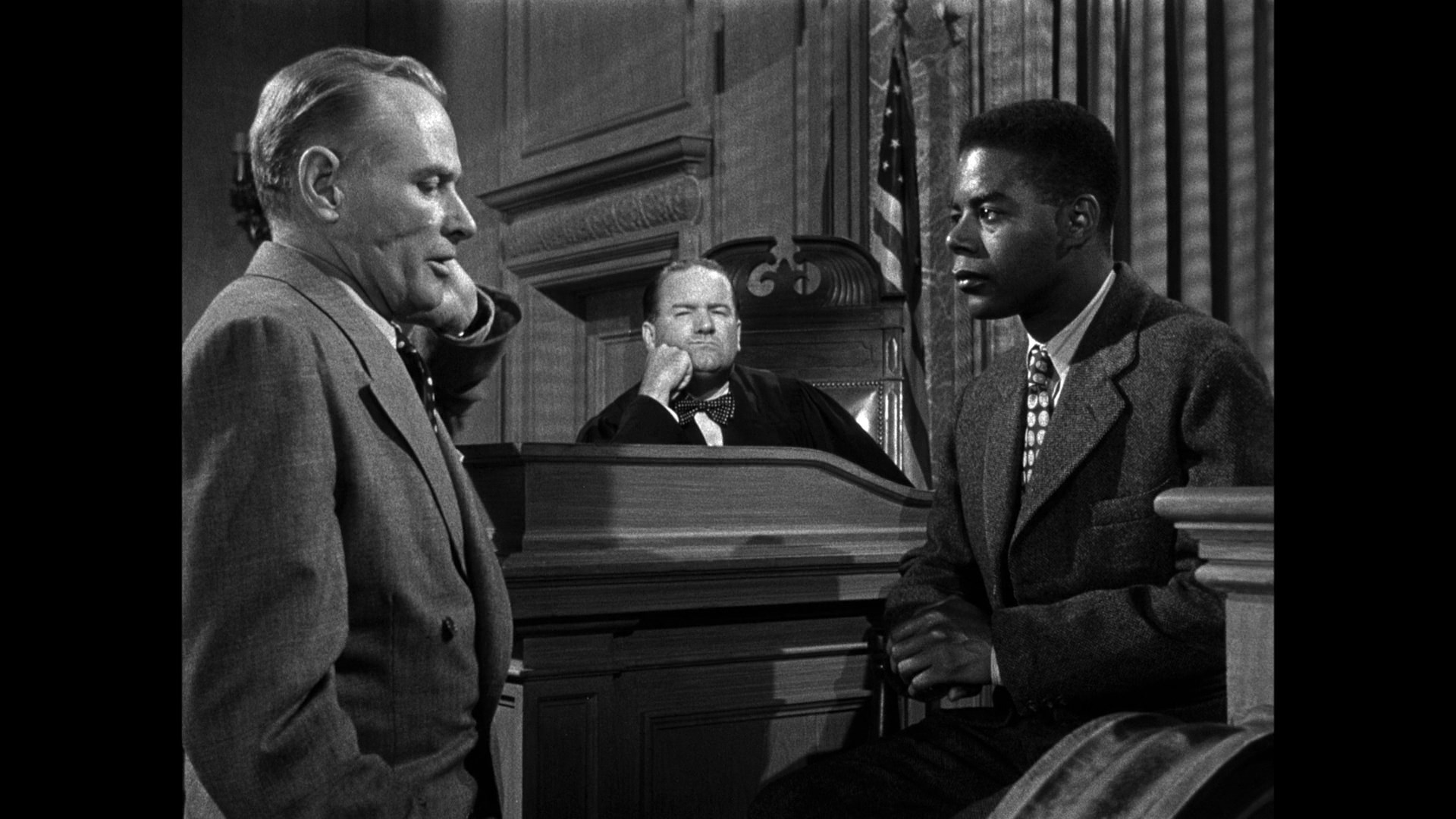 real-life dedication to social issues shining through. Despite his audacious debut with They Live by Night, Ray hadn't quite gotten his footing as a filmmaker here with several scenes displaying iffy editing and camera placement. Fortunately the strength of the story (adapted smoothly by future Academy president Daniel Taradash) and the star power at its center carry it over any bumpy spots and make it a minor classic of its kind. The film ended up having an identical home video trajectory as Dead Reckoning from VHS to DVD to French Blu-ray, with the Indicator coming out the clear winner here. The camera negative used for the Sony HD scan is in excellent condition here without any significant issues, and there's also a really insightful commentary by Pamela Hutchinson covering comparisons with the novel, the issues with Bogart going off on his own under Jack L. Warner's regime, the use of visual shorthand to convey the film's social stance, the origin of its most famous line of dialogue, the literary and cinematic sequel Let No Man Write My Epitaph, and connections to Ray's other work. In "Nobody Knows How Anybody Feels" (19m10s), Geoff Andrew discusses Ray's connection to the Chicago setting, the concessions to the Production Code, and the way the story resonates with the push for confirming to society that would escalate soon after. Tuesday in November (1945, 17m5s) is a doc short assistant directed by Ray about the importance of voting as part of the American process, produced as part of the Office of War’s The American Scene series and presented by the Library of Congress (and with a few lines of dialogue that play very differently today!). Last come the theatrical trailer and a gallery of 60 images.
real-life dedication to social issues shining through. Despite his audacious debut with They Live by Night, Ray hadn't quite gotten his footing as a filmmaker here with several scenes displaying iffy editing and camera placement. Fortunately the strength of the story (adapted smoothly by future Academy president Daniel Taradash) and the star power at its center carry it over any bumpy spots and make it a minor classic of its kind. The film ended up having an identical home video trajectory as Dead Reckoning from VHS to DVD to French Blu-ray, with the Indicator coming out the clear winner here. The camera negative used for the Sony HD scan is in excellent condition here without any significant issues, and there's also a really insightful commentary by Pamela Hutchinson covering comparisons with the novel, the issues with Bogart going off on his own under Jack L. Warner's regime, the use of visual shorthand to convey the film's social stance, the origin of its most famous line of dialogue, the literary and cinematic sequel Let No Man Write My Epitaph, and connections to Ray's other work. In "Nobody Knows How Anybody Feels" (19m10s), Geoff Andrew discusses Ray's connection to the Chicago setting, the concessions to the Production Code, and the way the story resonates with the push for confirming to society that would escalate soon after. Tuesday in November (1945, 17m5s) is a doc short assistant directed by Ray about the importance of voting as part of the American process, produced as part of the Office of War’s The American Scene series and presented by the Library of Congress (and with a few lines of dialogue that play very differently today!). Last come the theatrical trailer and a gallery of 60 images.
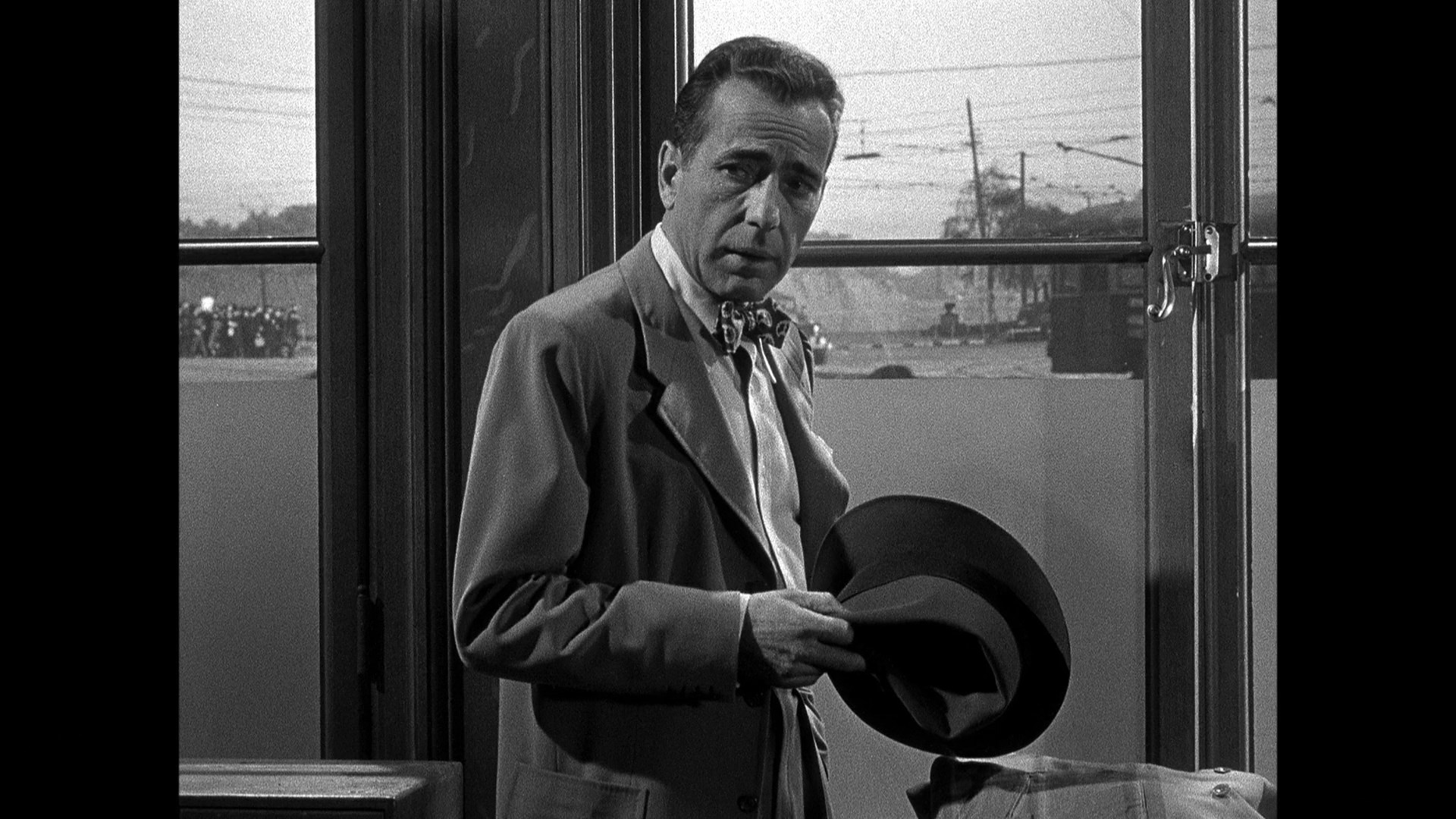 Somehow getting permission from
Somehow getting permission from 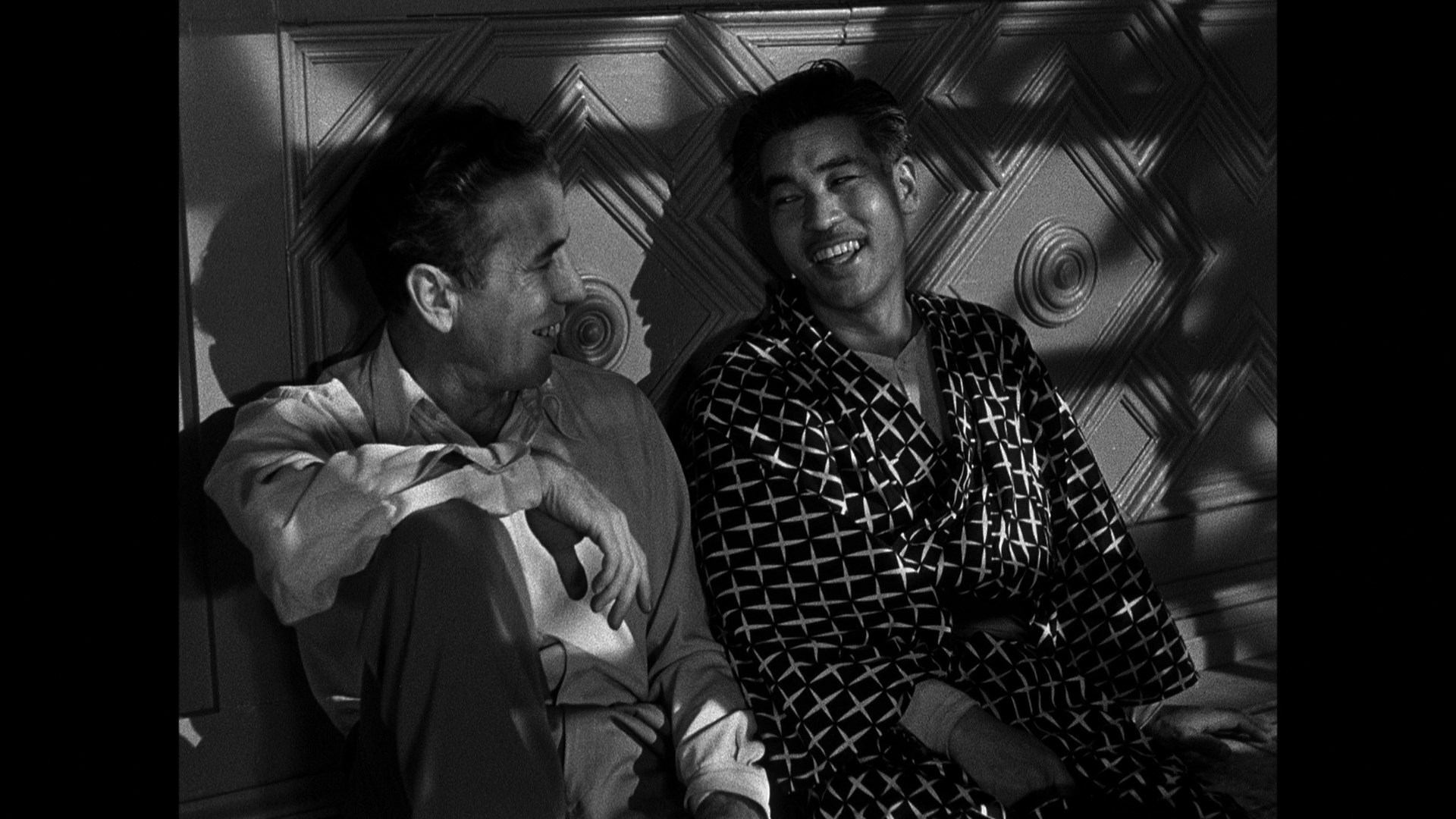 General MacArthur to shoot on location in Japan after World War II, Tokyo Joe is a minor Bogie entry by any standard (and other Santana outing) but is fascinating as a postwar stab at recapturing some of that Casablanca magic. Bogart actually didn't do any traveling, with a double standing in for location shots for his role as Joe Barrett, an American who heads back to Japan after the war to resume control of his nightclub after having a military powwow with none other than Leave It to Beaver's Hugh Beaumont. He discovers that his presumed-dead wife is now married to a lawyer, Mark (Knox), both of whom are instrumental in his setting up of a new indie airline business. Along the way with his two-month visa running out, he gets entangled in an illegal smuggling operation as well as a culture clash that could end in bloodshed.
General MacArthur to shoot on location in Japan after World War II, Tokyo Joe is a minor Bogie entry by any standard (and other Santana outing) but is fascinating as a postwar stab at recapturing some of that Casablanca magic. Bogart actually didn't do any traveling, with a double standing in for location shots for his role as Joe Barrett, an American who heads back to Japan after the war to resume control of his nightclub after having a military powwow with none other than Leave It to Beaver's Hugh Beaumont. He discovers that his presumed-dead wife is now married to a lawyer, Mark (Knox), both of whom are instrumental in his setting up of a new indie airline business. Along the way with his two-month visa running out, he gets entangled in an illegal smuggling operation as well as a culture clash that could end in bloodshed.
If you ever wanted to see Bogart doing a friendly judo fight, look no further than this entertaining crime yarn that makes a respectable attempt at respecting Japanese culture in a manner not typical of Hollywood at the time. In particular it features substantial roles for Teru Shimada (best known for later playing Osato in You Only Live Twice) and Sessue Hayakwa, who went on to an Oscar nomination for The Bride on the River Kwai. Cult movie fans will also get a kick out of seeing 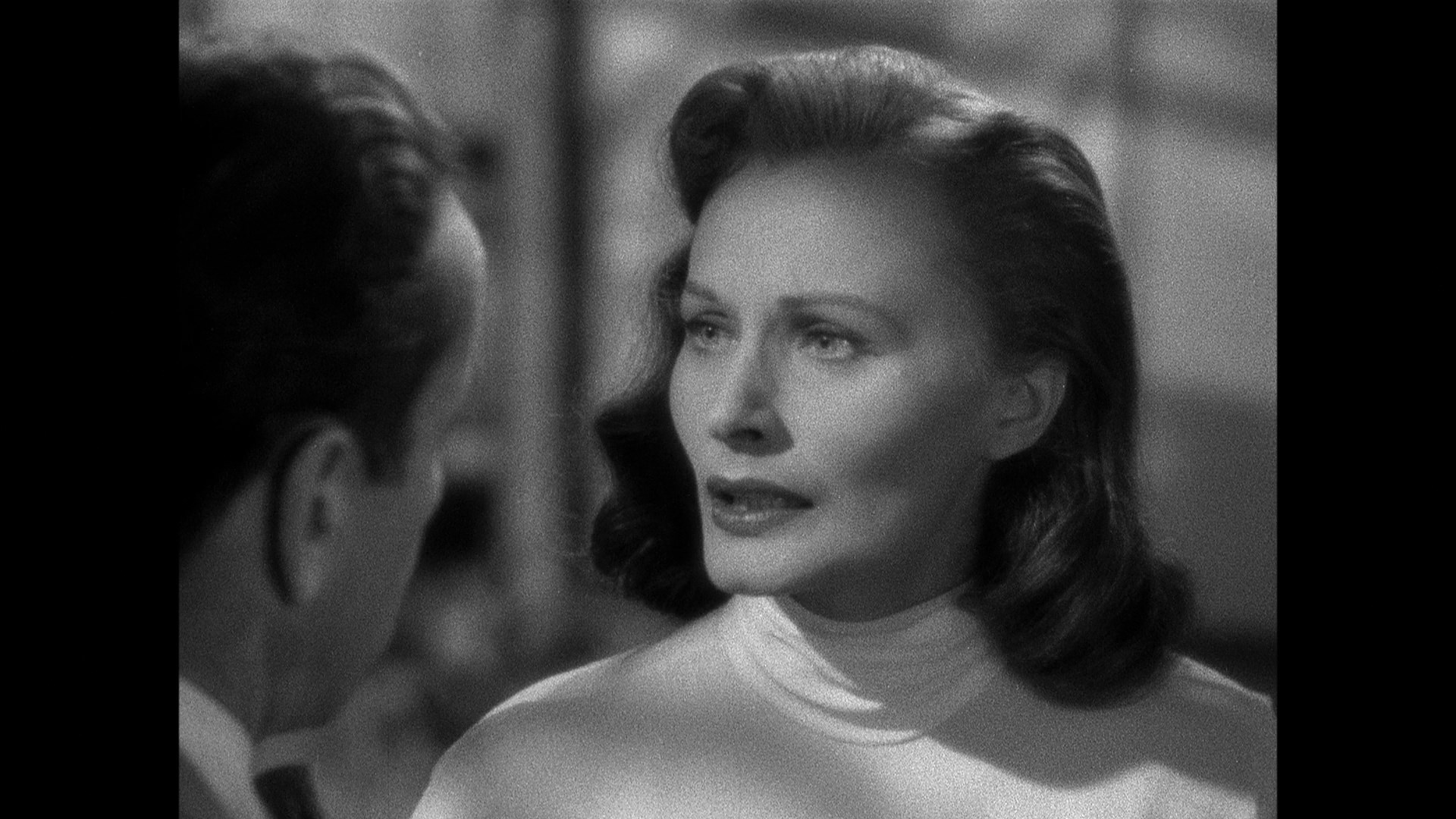 Bogart's onetime wife played by none other than the striking Florence Marly, who went to don green makeup as the title character in
Bogart's onetime wife played by none other than the striking Florence Marly, who went to don green makeup as the title character in 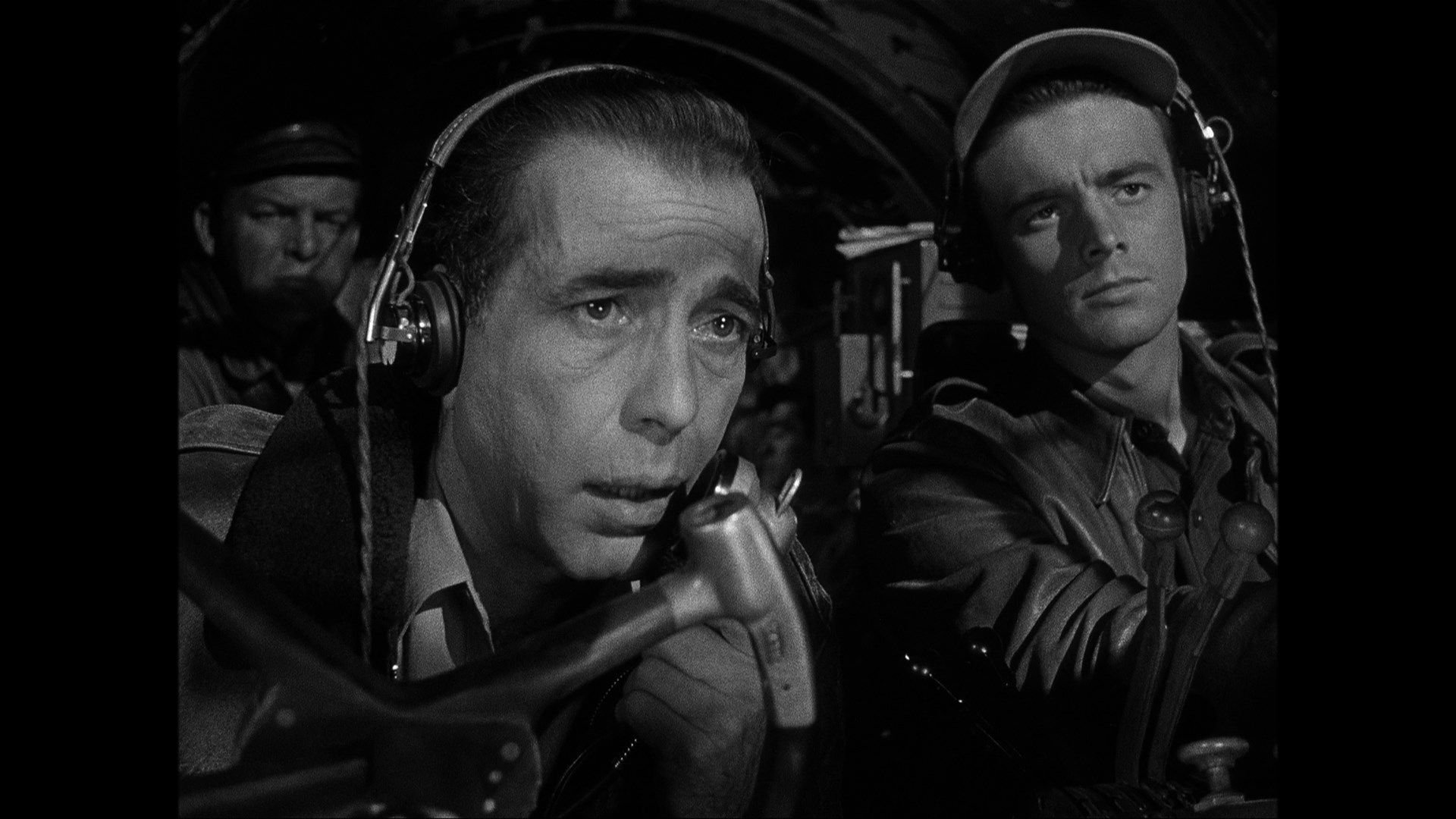 Curtis Harrington's Queen of Blood. Again this one hit VHS and DVD from RCA/Columbia and Sony in its various incarnations, with a Sidonis French Blu-ray in 2020. The French DVD and Blu-ray releases featured an appraisal of the film by legendary filmmaker Bertrand Tavernier (33m23s), which is thankfully ported over for the Indicator Blu-ray with a warm account of how he first encountered the film and what he appreciated about its director, Stuart Heisler (who directed Bogart again in Chain Lightning), as well as the documentary-style location shooting. The film itself again looks immaculate here, up to the usual Sony standards, and comes with a new, extensively researched commentary by Nora "The Nitrate Diva" Fiore who delivers tons of info about the cast, the unusual story behind the film, the more notable elements of the production design, and the moments featuring Bogart's double. In "A Superstar Returns" (14m16s), Tom Vincent delivers an interesting history of Hayakawa's career from his silent-era breakthrough in The Cheat through later career highlights, his travels around the world for various projects, his temporary fall from the public eye during World War II, and his eventual ascent to his most famous role. A reel of silent second unit photography (10m8s) shot by by second unit director Art Black and cameramen Joseph Biroc and Emil Oster Jr. is a great peek behind the scenes unearthed in Japan, while the Hesiler-directed The Negro Soldier (1944, 40m27s) is one of the filmmaker's most famous and significant achievements looking at the life at home from church services to domestic routines for African-American men as well as heroic figures from combat history. The short also features an audio study by Jim Pines from a BFI Southbank screening, filling in a lot more info about its creation as
Curtis Harrington's Queen of Blood. Again this one hit VHS and DVD from RCA/Columbia and Sony in its various incarnations, with a Sidonis French Blu-ray in 2020. The French DVD and Blu-ray releases featured an appraisal of the film by legendary filmmaker Bertrand Tavernier (33m23s), which is thankfully ported over for the Indicator Blu-ray with a warm account of how he first encountered the film and what he appreciated about its director, Stuart Heisler (who directed Bogart again in Chain Lightning), as well as the documentary-style location shooting. The film itself again looks immaculate here, up to the usual Sony standards, and comes with a new, extensively researched commentary by Nora "The Nitrate Diva" Fiore who delivers tons of info about the cast, the unusual story behind the film, the more notable elements of the production design, and the moments featuring Bogart's double. In "A Superstar Returns" (14m16s), Tom Vincent delivers an interesting history of Hayakawa's career from his silent-era breakthrough in The Cheat through later career highlights, his travels around the world for various projects, his temporary fall from the public eye during World War II, and his eventual ascent to his most famous role. A reel of silent second unit photography (10m8s) shot by by second unit director Art Black and cameramen Joseph Biroc and Emil Oster Jr. is a great peek behind the scenes unearthed in Japan, while the Hesiler-directed The Negro Soldier (1944, 40m27s) is one of the filmmaker's most famous and significant achievements looking at the life at home from church services to domestic routines for African-American men as well as heroic figures from combat history. The short also features an audio study by Jim Pines from a BFI Southbank screening, filling in a lot more info about its creation as  well as the
well as the 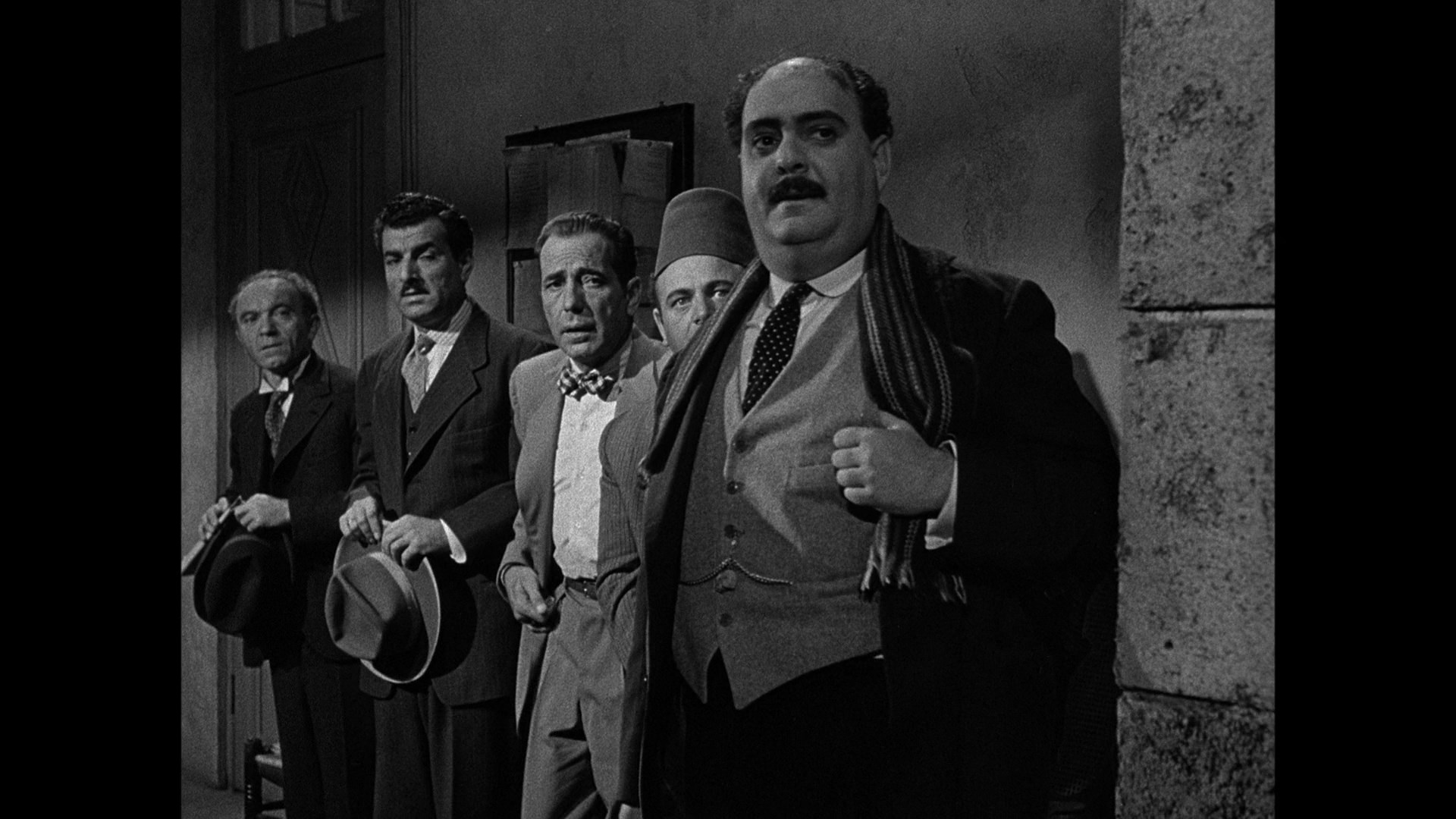 real soldiers discussed during the running time. Also included is a 29-image gallery of photos and promotional material.
real soldiers discussed during the running time. Also included is a 29-image gallery of photos and promotional material.
Continuing the Casablanca influence is 1951's Sirocco, with him cast once again as jaded American ex-pat in a strange land-- Syria, in this case. Here he's black market dealer Harry Smith, who's running arms in 1920s Damascus where the occupying French are cleaning house of anyone who might pose a threat. Colonel Feroud (Lee J. Cobb, excellent as always) is among the more sympathetic of the men in power, and both he and Harry become involved in a love triangle with Violetta (Torén), who might as well be named Ilsa. Harry's ties to the rebels become a major liability for him as he contemplates taking off with Violetta versus taking action in a powder keg where loyalties seem to shift by the hour.
Thanks to Cobb and a few colorful supporting bits (most notably a young, hammy Zero Mostel), Sirocco passes muster as a diverting time killer even if it ranks very far down in the Bogart filmography. The morose and overly familiar storyline (especially the ending) and wildly unconvincing attempts to pass off Hollywood sets and Yuma, Arizona exteriors as Syria are the biggest issues, but then again it's still plenty of Bogart here to keep fans happy. As opposed 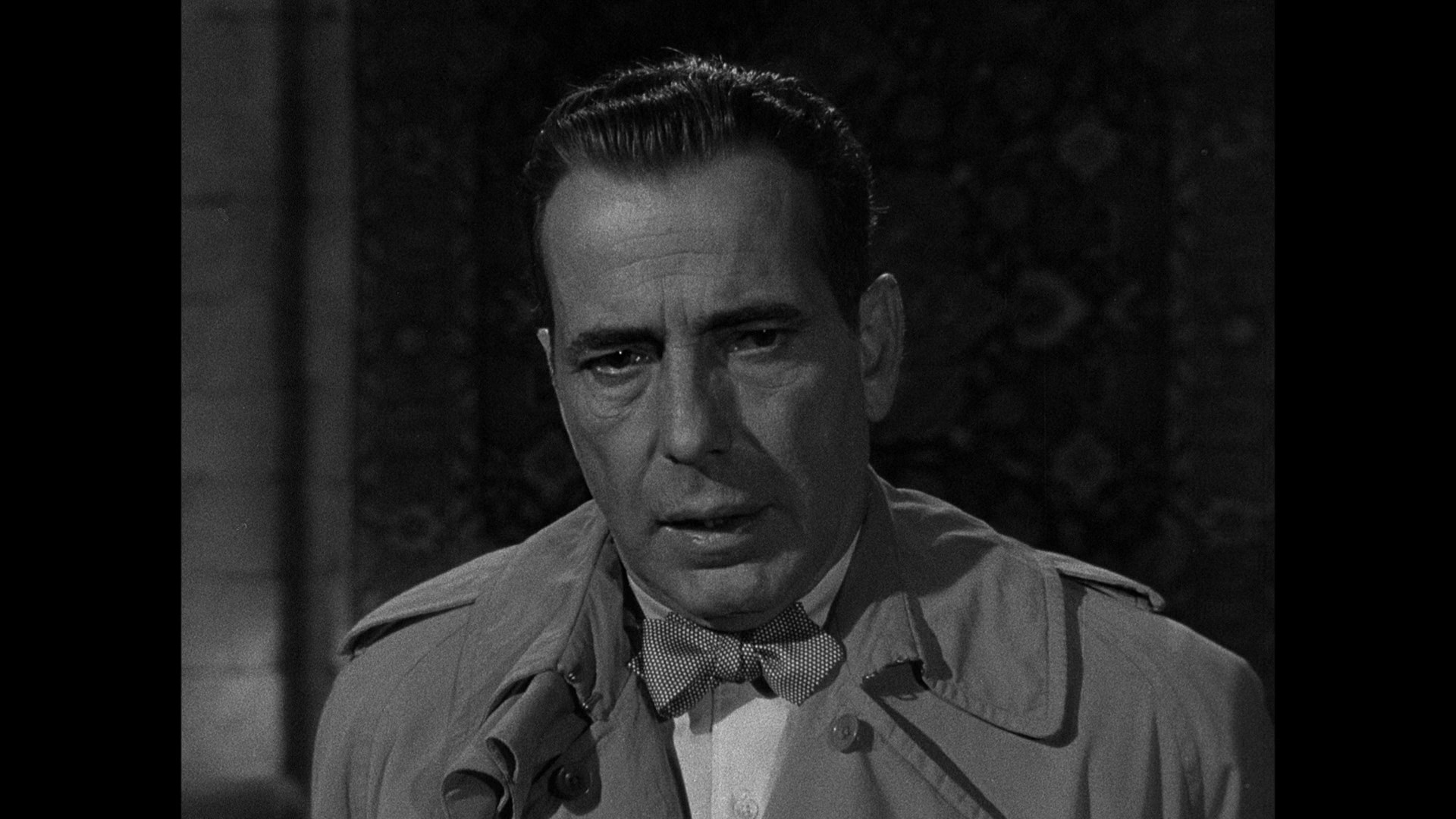 to Tokyo Joe, the
to Tokyo Joe, the 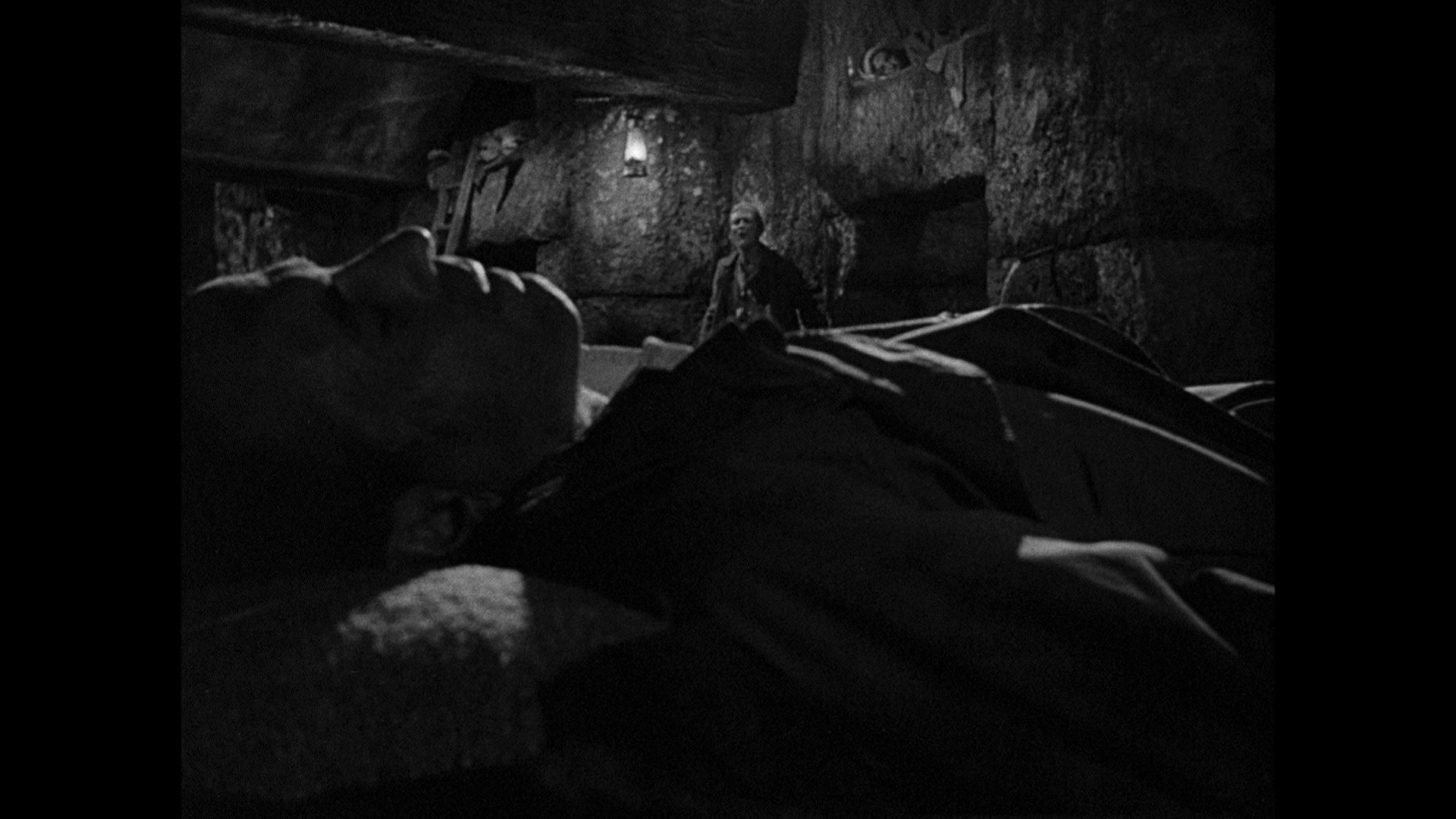 portrayal of Arabs here is a lot more reductive with fezes and brownface makeup aplenty making this more typical of the era. Ace cinematographer Burnett Guffey (who had already done In a Lonely Place and lots of other Columbia films) does wring some nice visuals out of here at times though with light and shadow, which presumably is the biggest element that gets this classified as a marginal noir. Again this one hit DVD and VHS from Sony (with a stopover on laserdisc from Image), but it hasn't been on Blu-ray anywhere in the world until the Indicator release. They certainly do present it as well as possible with another pristine transfer that handles the frequently dark imagery quite well. It also comes with an audio commentary by Alexandra Heller-Nicholas and Josh Nelson who deliver a track that's actually more substantive than the film itself, delivering a relevant history of Syria, noting differences from the French source novel Coup de Grace by Joseph Kessel (in which Violetta was 15!), and analyzing the portrayals of Arabs and terrorist imagery in Hollywood. A 1997 episode of The South Bank Show, "Bogart: Here’s Looking at You, Kid" (51m31s), with the actor's son Stephen covering highlights from his father's life and career culled from his own investigations into his family's past. A 37-image gallery is also included.
portrayal of Arabs here is a lot more reductive with fezes and brownface makeup aplenty making this more typical of the era. Ace cinematographer Burnett Guffey (who had already done In a Lonely Place and lots of other Columbia films) does wring some nice visuals out of here at times though with light and shadow, which presumably is the biggest element that gets this classified as a marginal noir. Again this one hit DVD and VHS from Sony (with a stopover on laserdisc from Image), but it hasn't been on Blu-ray anywhere in the world until the Indicator release. They certainly do present it as well as possible with another pristine transfer that handles the frequently dark imagery quite well. It also comes with an audio commentary by Alexandra Heller-Nicholas and Josh Nelson who deliver a track that's actually more substantive than the film itself, delivering a relevant history of Syria, noting differences from the French source novel Coup de Grace by Joseph Kessel (in which Violetta was 15!), and analyzing the portrayals of Arabs and terrorist imagery in Hollywood. A 1997 episode of The South Bank Show, "Bogart: Here’s Looking at You, Kid" (51m31s), with the actor's son Stephen covering highlights from his father's life and career culled from his own investigations into his family's past. A 37-image gallery is also included.
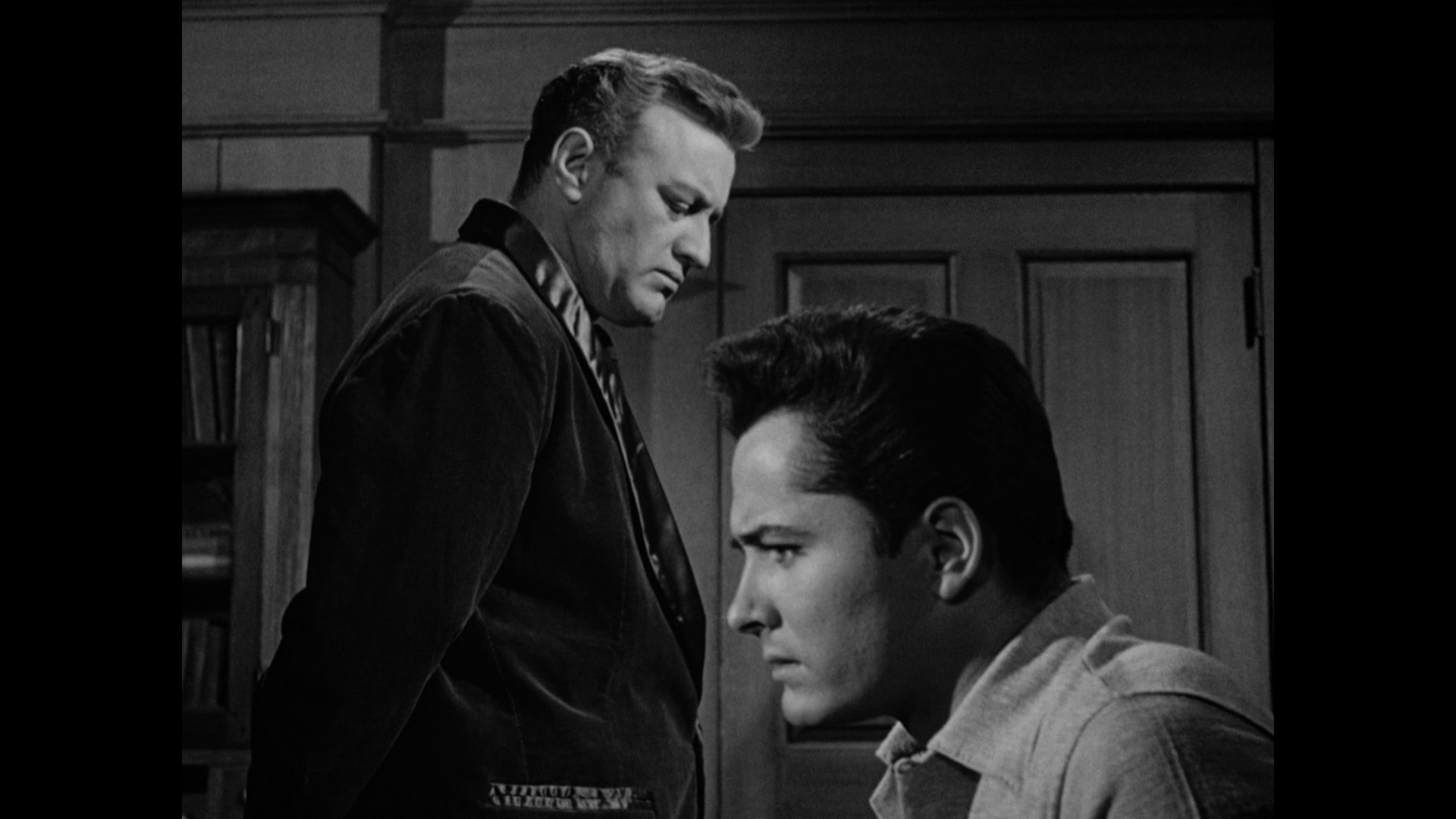 Film number five is easily the most obscure one in the set: The Family Secret, released in
Film number five is easily the most obscure one in the set: The Family Secret, released in 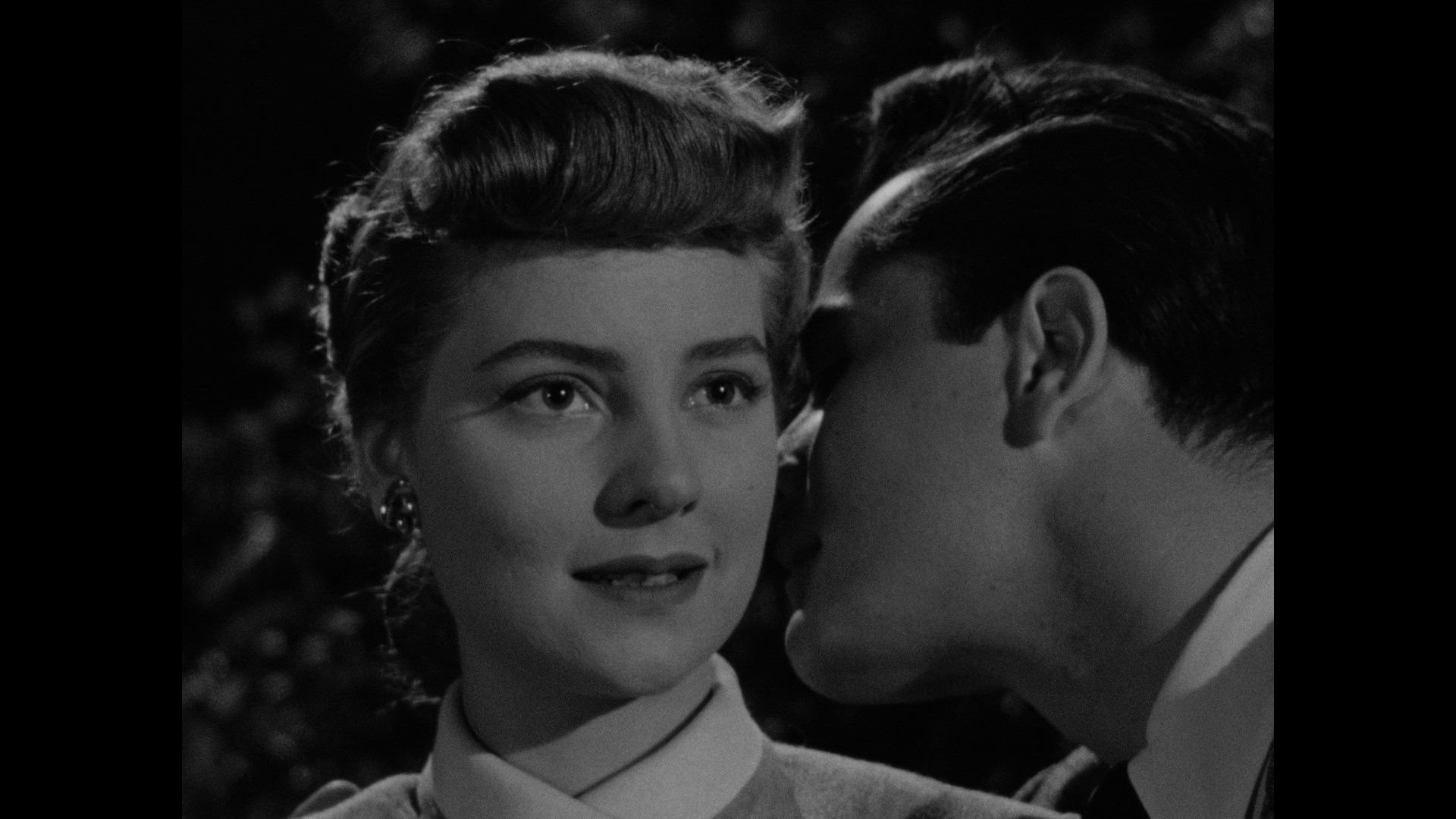 1951 and one of the last Santana outings along with the troubled Beat the Devil. Bogart doesn't even show up on screen in this one, but he did serve as an uncredited producer which is enough to still let it squeak by. Anyone who's already watched Knock on Any Door will get a certain sense of deja vu here as Derek is cast once again as a young man involved in a murder, though this time he's a moping rich brat law student named David Clark who has to confess to his lawyer dad, Howard (Cobb), that he killed his best friend during a fight. Despite the fact that the circumstances would at least merit a manslaughter charge, David won't turn himself in and instead lets a bookie with a heart condition take the fall for the killing. Meanwhile David seems a lot more interested in pursuing his dad's secretary, Lee (Lawrence), than doing the right thing when Howard ends up representing the innocent man in court. What will it take for David to finally stand up and admit what he's done?
1951 and one of the last Santana outings along with the troubled Beat the Devil. Bogart doesn't even show up on screen in this one, but he did serve as an uncredited producer which is enough to still let it squeak by. Anyone who's already watched Knock on Any Door will get a certain sense of deja vu here as Derek is cast once again as a young man involved in a murder, though this time he's a moping rich brat law student named David Clark who has to confess to his lawyer dad, Howard (Cobb), that he killed his best friend during a fight. Despite the fact that the circumstances would at least merit a manslaughter charge, David won't turn himself in and instead lets a bookie with a heart condition take the fall for the killing. Meanwhile David seems a lot more interested in pursuing his dad's secretary, Lee (Lawrence), than doing the right thing when Howard ends up representing the innocent man in court. What will it take for David to finally stand up and admit what he's done?
As you can probably guess from the synopsis, this is a rather strange film that tries to elicit viewer sympathy for a pretty reprehensible main character (who also forces himself on Lee in one of his many icky moments). At this point cracks were starting to show in the press' breathless touting of Derek as the next hot thing, and it's really Cobb who steals the show here with a low-key but 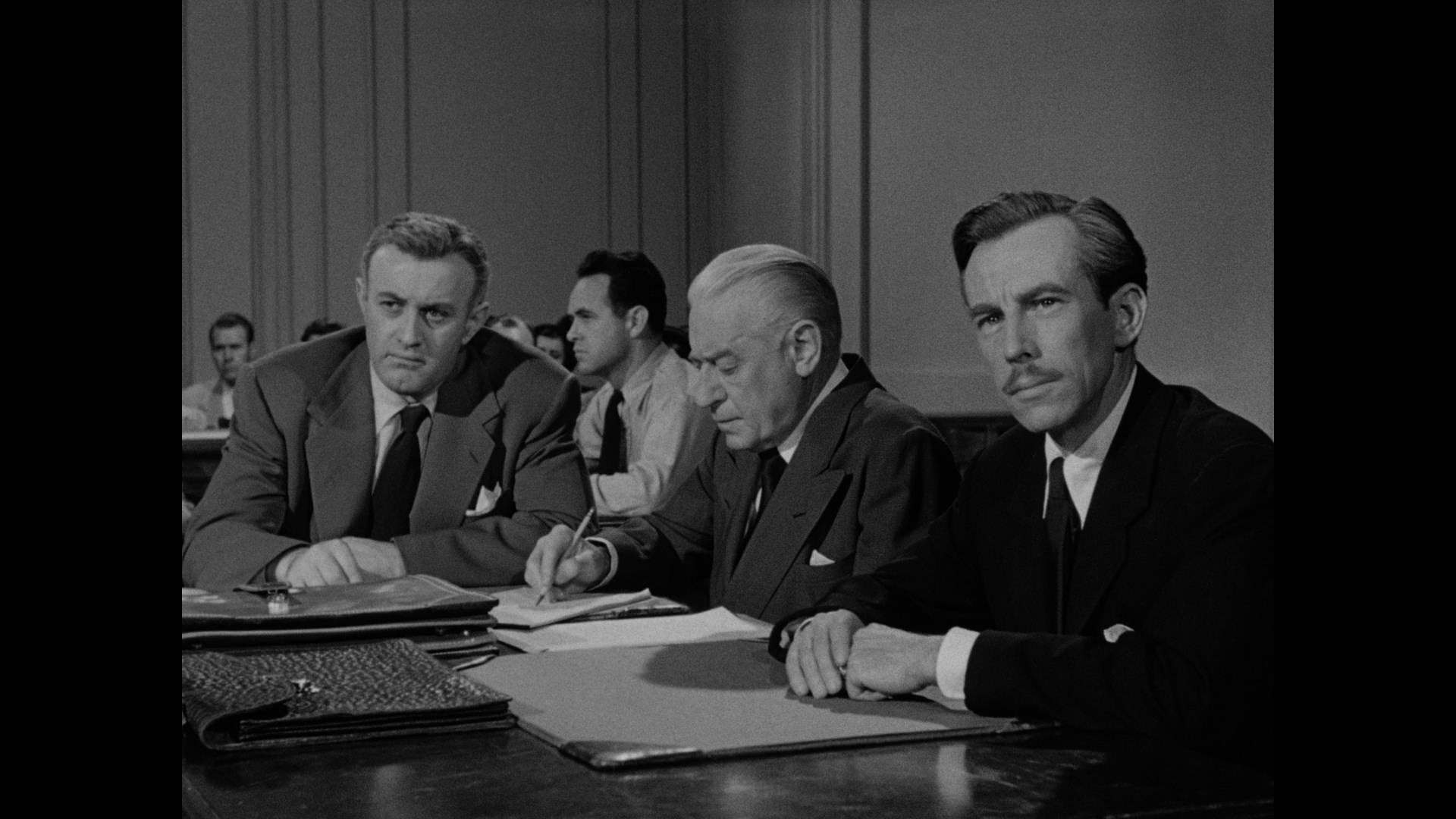 interesting performance that hints at a lot more going on under the surface. Erin
interesting performance that hints at a lot more going on under the surface. Erin 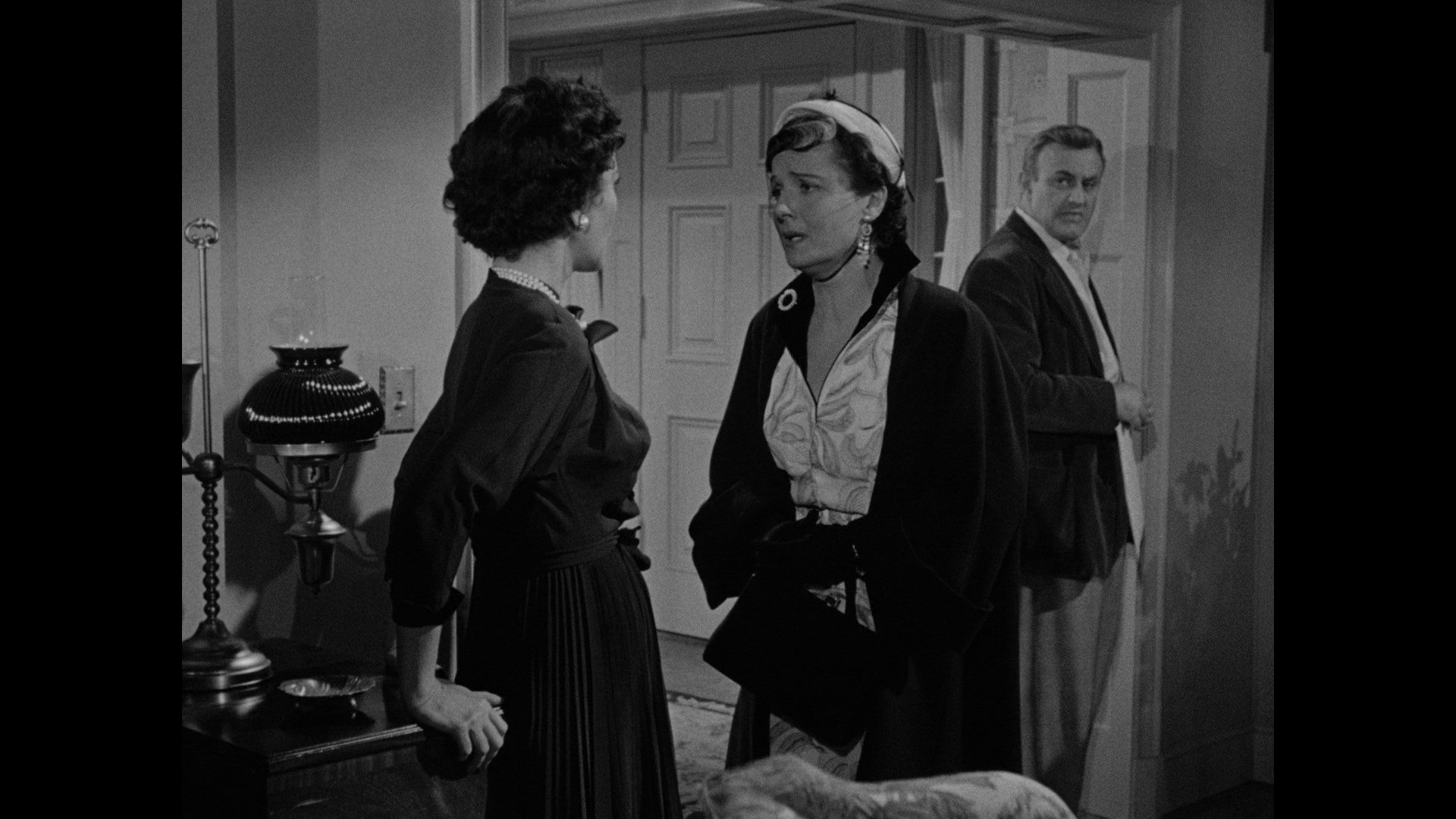 O'Brien-Moore also registers well as the family matriarch who has her own opinions about the conflict between father and son, which would seem to be the driving dramatic force here but ends up taking a back seat once the court drama gets underway. Despite its obvious faults though, the film is fascinating as a screenwriting exercise for what it tries to do and what the actors bring to it, essentially turning it into an object lesson in how audience sympathies can be a tricky thing that make or break the overall effectiveness of a story.
O'Brien-Moore also registers well as the family matriarch who has her own opinions about the conflict between father and son, which would seem to be the driving dramatic force here but ends up taking a back seat once the court drama gets underway. Despite its obvious faults though, the film is fascinating as a screenwriting exercise for what it tries to do and what the actors bring to it, essentially turning it into an object lesson in how audience sympathies can be a tricky thing that make or break the overall effectiveness of a story.
A complete nonentity at the box office when it opened, The Family Secret has mostly flown under the radar ever since with only a Sony Choice Collection DVD-R giving it a shot at much exposure until the Indicator Blu-ray. Again the film looks terrific (Guffey's touch shines through again), but the biggest plus here might be the commentary by Jason A. Ney who convincingly argues that covering a flawed film can often be more interesting and illuminating than an undisputed masterpiece. There's a ton of great material in here including material on the actors (especially the tragic fire incident that impacted O'Brien-Moore's career), the issues created by the script flaws, the involvement of Bogart and the state of his company that was pretty much polished off thanks to this and the even lesser seen And Baby Makes Three. He isn't too enamored with Derek's character either, hilariously commenting "What a jerk!" after one really nasty line of dialogue. Director Henry Levin is also represented here with 1945's The Negro Sailor (26m49s), another World War II doc short here recruiting younger African-American viewers to sign up for the Navy. 1954's The Big Moment (25m23s) is a short film produced by the United Jewish Appeal hosted by Robert Young looking at how to steer the destitute into becoming productive members of society-- including John Derek and Donna Reed as Israeli settlers starting a new life. (This would make a really interesting intro film for The Ten Commandments!) A 32- image gallery is also
image gallery is also 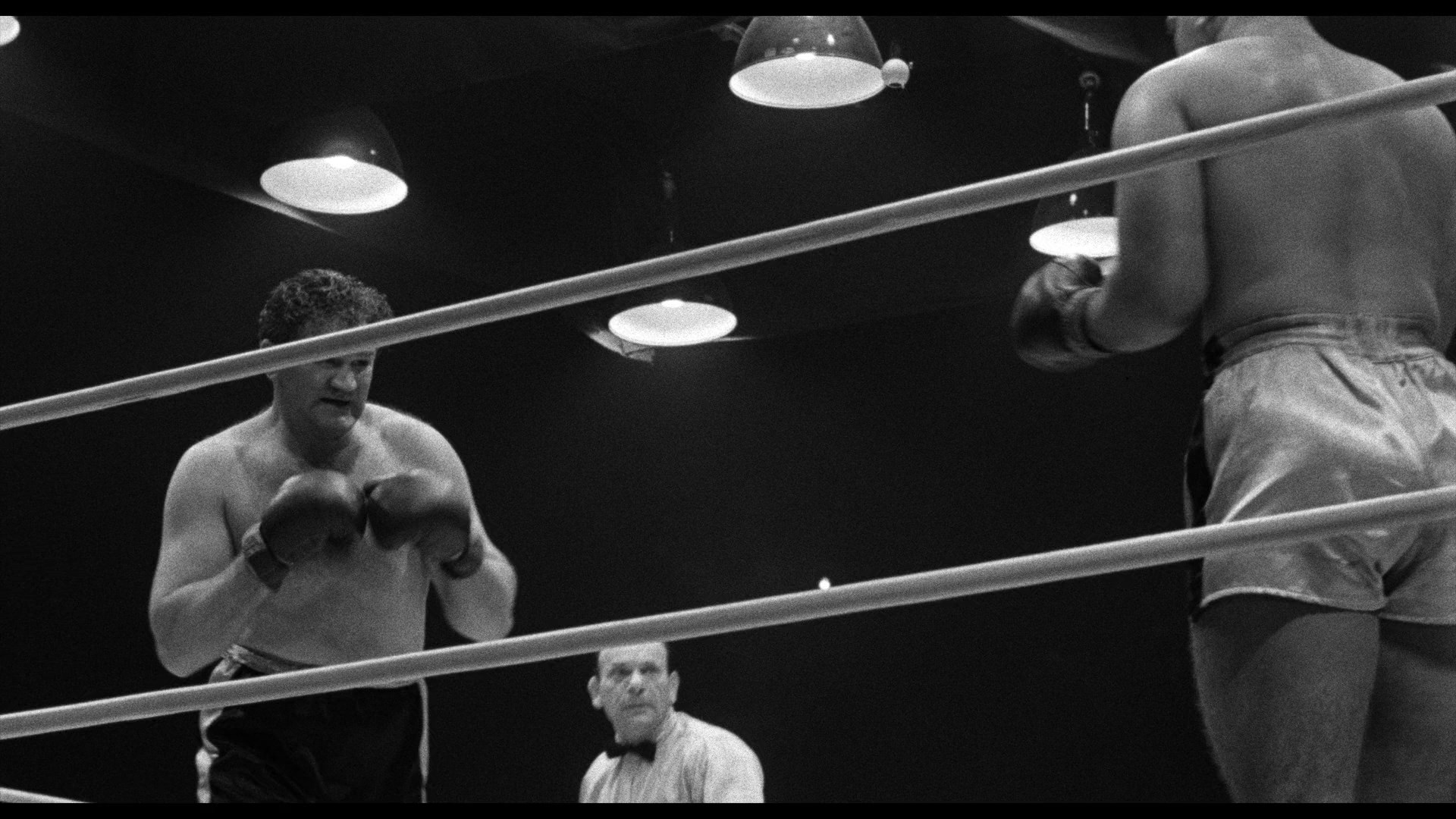 included.
included.
Finally on disc six we get to a sterling 4K restoration of arguably the biggest film in the set, 1956's The Harder They Fall, a hard-bitten boxing film showing the dark underbelly of the violent sport. Directed by Mark Robson, it stars Bogart as sports writer Eddie Willis, a seen-it-all type who finds himself out of a job. The first opportunity to present itself comes from blustering promoter Nick Benko (Steiger) who's pushing his newest find, Toro Moreno (Lane), a towering hulk of a guy from Argentina who actually can't fight to save his life. In fact Benko is fixing the fights to help promote his latest cash cow, something that begins to increasingly disturb Eddie -- especially when the ruse starts to have a body count.
Once again Guffey steps behind the camera (and earned an Oscar nomination for his work) including some stark and atmospheric fight scenes, while Bogart and Steiger really crackle off of each other here. The fact that Bogart was ailing with cancer (this would be his last role) gives it even more resonance, and even those with little interest in boxing will find this gripping from the opening moments thanks to its dynamic visual execution. Presumably because of the subject matter it's also quite a bit bloodier than usual for a '56 Hollywood film, and the ultimate message still carries a lot of weight today (especially given the more recent scandals plaguing the NFL). Noir fans will also get a kick out of seeing a substantial role for Jan Sterling (Ace in the Hole), as usual making the most 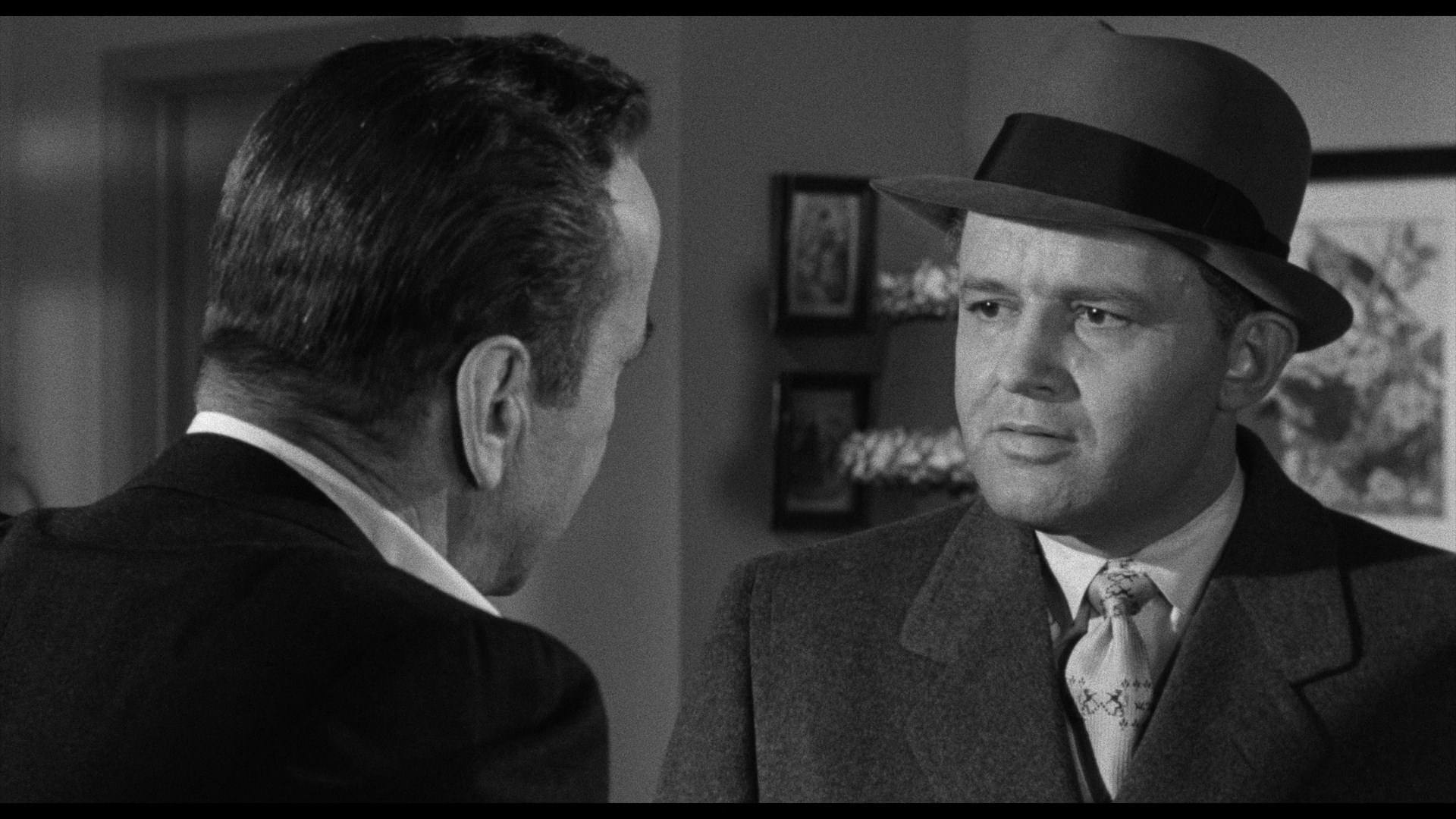 out of a role
out of a role  that was probably far less interesting on paper.
that was probably far less interesting on paper.
Once again this followed the path of Sony VHS and DVD with an eventual dual-format French release including a Tavernier featurette (29m41s), carried over here with English subtitles. New here is a dense and observant commentary by Glenn Kenny and Farran Smith Nehme who balance trivia (like the real punch-drunk boxer interviewed in one scene) with critical observations about the film's treatment of its subject and placement within the Bogart filmography. In "The Final Bout" (10m24s), Christina Newland discusses the failing state of Bogart's health at the time and the film's relationship to its source novel by Budd Schulberg (On the Waterfront, A Face in the Crowd), who had some issues with the film's conclusion (which was softened for TV airings, though that isn't included here). Real-life boxer Max Baer, who turns up as an actor in the film, turns up here in two Super 8 films, 1933's bout with Max Schmeling (2m49s) and a 1934 one against Primo Carnera (2m51s), while you get to see a different side of Schulberg with his script for the George Stevens-directed That Justice Be Done (10m30s), a translated chronicle of the Nuremberg trials (plus a moody narrated intro with Thomas Jefferson). A 36-image gallery is also included, and as usual the deluxe packaging pulls out all the stops with a 120-page book featuring a new essay by Imogen Sara Smith, several archival articles and interviews, and notes on the short films.
Reviewed on July 10, 2022



 Indicator to jump back into the waters of its Columbia postwar film noir releases, which began
Indicator to jump back into the waters of its Columbia postwar film noir releases, which began  with Columbia Noir #1 and kept going with Columbia Noir #2, Columbia Noir #3, and Columbia Noir #4. This time they go for a more unified series with the limited 6,000-unit Columbia Noir #5: Humphrey Bogart, encompassing a nine-year stretch for the beloved leading man at Columbia (leading up to right before his death) in the wake of his beloved hits like The Maltese Falcon, The Big Sleep, and Casablanca. Most of these have been widely available on home video before but look fantastic here, with one significant rarity added from Bogart's work as a producer rather than an actor. It also serves as a kind of spotlight for Bogart's own Santana Productions and its stable of actors including a young John Derek, long before he went on to notoriety focusing on his wife, Bo. As usual the definition of noir gets stretched a lot here with multiple titles really classified more accurately as straight-up melodramas, but it's great to have them in HD all the same with the usual bounty of substantial bonus features.
with Columbia Noir #1 and kept going with Columbia Noir #2, Columbia Noir #3, and Columbia Noir #4. This time they go for a more unified series with the limited 6,000-unit Columbia Noir #5: Humphrey Bogart, encompassing a nine-year stretch for the beloved leading man at Columbia (leading up to right before his death) in the wake of his beloved hits like The Maltese Falcon, The Big Sleep, and Casablanca. Most of these have been widely available on home video before but look fantastic here, with one significant rarity added from Bogart's work as a producer rather than an actor. It also serves as a kind of spotlight for Bogart's own Santana Productions and its stable of actors including a young John Derek, long before he went on to notoriety focusing on his wife, Bo. As usual the definition of noir gets stretched a lot here with multiple titles really classified more accurately as straight-up melodramas, but it's great to have them in HD all the same with the usual bounty of substantial bonus features. noir tropes delivering with gritty panache and anchored by a typically solid performance by Bogart
noir tropes delivering with gritty panache and anchored by a typically solid performance by Bogart  doing what he does best.
doing what he does best. Next we skip ahead two years for Knock on Any Door, best known today as the second
Next we skip ahead two years for Knock on Any Door, best known today as the second  (or third, depending how you're counting) film directed by Nicholas Ray (who would reteam with Bogart more famously again with In a Lonely Place). Essentially a combination of troubled youth drama and courtroom thriller, this film (the first in the set from Bogart's Santana Productions but far from the last) was quickly adapted from a bestselling 1947 novel by Willard Motley with Derek enthusiastically approaching Bogart and company for what would be his feature film debut. In Chicago's skid row, slum kid Nick Romano (Derek) is nabbed by the police for the shooting death of an officer late at night. Still feeling guilty over his botched defense of Nick's dad, attorney Andrew Morton (Bogart) is goaded by his wife (Coxton) into defending Nick whom he believes is an innocent production of society's ills. Nick's famous motto, "Live fast, die young, and have a good-looking corpse," is dramatized in flashbacks as we see him bouncing through a challenging life that seems to always force him to turn to crime, which culminates in the trial that will determine his life or death.
(or third, depending how you're counting) film directed by Nicholas Ray (who would reteam with Bogart more famously again with In a Lonely Place). Essentially a combination of troubled youth drama and courtroom thriller, this film (the first in the set from Bogart's Santana Productions but far from the last) was quickly adapted from a bestselling 1947 novel by Willard Motley with Derek enthusiastically approaching Bogart and company for what would be his feature film debut. In Chicago's skid row, slum kid Nick Romano (Derek) is nabbed by the police for the shooting death of an officer late at night. Still feeling guilty over his botched defense of Nick's dad, attorney Andrew Morton (Bogart) is goaded by his wife (Coxton) into defending Nick whom he believes is an innocent production of society's ills. Nick's famous motto, "Live fast, die young, and have a good-looking corpse," is dramatized in flashbacks as we see him bouncing through a challenging life that seems to always force him to turn to crime, which culminates in the trial that will determine his life or death.  demonstrating the motivations behind his illegal behavior. Any film that lets Bogart monologue is obviously going to be worth a look, and this one really delivers especially in the courtroom scenes with Bogart's
demonstrating the motivations behind his illegal behavior. Any film that lets Bogart monologue is obviously going to be worth a look, and this one really delivers especially in the courtroom scenes with Bogart's  real-life dedication to social issues shining through. Despite his audacious debut with They Live by Night, Ray hadn't quite gotten his footing as a filmmaker here with several scenes displaying iffy editing and camera placement. Fortunately the strength of the story (adapted smoothly by future Academy president Daniel Taradash) and the star power at its center carry it over any bumpy spots and make it a minor classic of its kind. The film ended up having an identical home video trajectory as Dead Reckoning from VHS to DVD to French Blu-ray, with the Indicator coming out the clear winner here. The camera negative used for the Sony HD scan is in excellent condition here without any significant issues, and there's also a really insightful commentary by Pamela Hutchinson covering comparisons with the novel, the issues with Bogart going off on his own under Jack L. Warner's regime, the use of visual shorthand to convey the film's social stance, the origin of its most famous line of dialogue, the literary and cinematic sequel Let No Man Write My Epitaph, and connections to Ray's other work. In "Nobody Knows How Anybody Feels" (19m10s), Geoff Andrew discusses Ray's connection to the Chicago setting, the concessions to the Production Code, and the way the story resonates with the push for confirming to society that would escalate soon after. Tuesday in November (1945, 17m5s) is a doc short assistant directed by Ray about the importance of voting as part of the American process, produced as part of the Office of War’s The American Scene series and presented by the Library of Congress (and with a few lines of dialogue that play very differently today!). Last come the theatrical trailer and a gallery of 60 images.
real-life dedication to social issues shining through. Despite his audacious debut with They Live by Night, Ray hadn't quite gotten his footing as a filmmaker here with several scenes displaying iffy editing and camera placement. Fortunately the strength of the story (adapted smoothly by future Academy president Daniel Taradash) and the star power at its center carry it over any bumpy spots and make it a minor classic of its kind. The film ended up having an identical home video trajectory as Dead Reckoning from VHS to DVD to French Blu-ray, with the Indicator coming out the clear winner here. The camera negative used for the Sony HD scan is in excellent condition here without any significant issues, and there's also a really insightful commentary by Pamela Hutchinson covering comparisons with the novel, the issues with Bogart going off on his own under Jack L. Warner's regime, the use of visual shorthand to convey the film's social stance, the origin of its most famous line of dialogue, the literary and cinematic sequel Let No Man Write My Epitaph, and connections to Ray's other work. In "Nobody Knows How Anybody Feels" (19m10s), Geoff Andrew discusses Ray's connection to the Chicago setting, the concessions to the Production Code, and the way the story resonates with the push for confirming to society that would escalate soon after. Tuesday in November (1945, 17m5s) is a doc short assistant directed by Ray about the importance of voting as part of the American process, produced as part of the Office of War’s The American Scene series and presented by the Library of Congress (and with a few lines of dialogue that play very differently today!). Last come the theatrical trailer and a gallery of 60 images. Somehow getting permission from
Somehow getting permission from  General MacArthur to shoot on location in Japan after World War II, Tokyo Joe is a minor Bogie entry by any standard (and other Santana outing) but is fascinating as a postwar stab at recapturing some of that Casablanca magic. Bogart actually didn't do any traveling, with a double standing in for location shots for his role as Joe Barrett, an American who heads back to Japan after the war to resume control of his nightclub after having a military powwow with none other than Leave It to Beaver's Hugh Beaumont. He discovers that his presumed-dead wife is now married to a lawyer, Mark (Knox), both of whom are instrumental in his setting up of a new indie airline business. Along the way with his two-month visa running out, he gets entangled in an illegal smuggling operation as well as a culture clash that could end in bloodshed.
General MacArthur to shoot on location in Japan after World War II, Tokyo Joe is a minor Bogie entry by any standard (and other Santana outing) but is fascinating as a postwar stab at recapturing some of that Casablanca magic. Bogart actually didn't do any traveling, with a double standing in for location shots for his role as Joe Barrett, an American who heads back to Japan after the war to resume control of his nightclub after having a military powwow with none other than Leave It to Beaver's Hugh Beaumont. He discovers that his presumed-dead wife is now married to a lawyer, Mark (Knox), both of whom are instrumental in his setting up of a new indie airline business. Along the way with his two-month visa running out, he gets entangled in an illegal smuggling operation as well as a culture clash that could end in bloodshed. Bogart's onetime wife played by none other than the striking Florence Marly, who went to don green makeup as the title character in
Bogart's onetime wife played by none other than the striking Florence Marly, who went to don green makeup as the title character in  Curtis Harrington's Queen of Blood. Again this one hit VHS and DVD from RCA/Columbia and Sony in its various incarnations, with a Sidonis French Blu-ray in 2020. The French DVD and Blu-ray releases featured an appraisal of the film by legendary filmmaker Bertrand Tavernier (33m23s), which is thankfully ported over for the Indicator Blu-ray with a warm account of how he first encountered the film and what he appreciated about its director, Stuart Heisler (who directed Bogart again in Chain Lightning), as well as the documentary-style location shooting. The film itself again looks immaculate here, up to the usual Sony standards, and comes with a new, extensively researched commentary by Nora "The Nitrate Diva" Fiore who delivers tons of info about the cast, the unusual story behind the film, the more notable elements of the production design, and the moments featuring Bogart's double. In "A Superstar Returns" (14m16s), Tom Vincent delivers an interesting history of Hayakawa's career from his silent-era breakthrough in The Cheat through later career highlights, his travels around the world for various projects, his temporary fall from the public eye during World War II, and his eventual ascent to his most famous role. A reel of silent second unit photography (10m8s) shot by by second unit director Art Black and cameramen Joseph Biroc and Emil Oster Jr. is a great peek behind the scenes unearthed in Japan, while the Hesiler-directed The Negro Soldier (1944, 40m27s) is one of the filmmaker's most famous and significant achievements looking at the life at home from church services to domestic routines for African-American men as well as heroic figures from combat history. The short also features an audio study by Jim Pines from a BFI Southbank screening, filling in a lot more info about its creation as
Curtis Harrington's Queen of Blood. Again this one hit VHS and DVD from RCA/Columbia and Sony in its various incarnations, with a Sidonis French Blu-ray in 2020. The French DVD and Blu-ray releases featured an appraisal of the film by legendary filmmaker Bertrand Tavernier (33m23s), which is thankfully ported over for the Indicator Blu-ray with a warm account of how he first encountered the film and what he appreciated about its director, Stuart Heisler (who directed Bogart again in Chain Lightning), as well as the documentary-style location shooting. The film itself again looks immaculate here, up to the usual Sony standards, and comes with a new, extensively researched commentary by Nora "The Nitrate Diva" Fiore who delivers tons of info about the cast, the unusual story behind the film, the more notable elements of the production design, and the moments featuring Bogart's double. In "A Superstar Returns" (14m16s), Tom Vincent delivers an interesting history of Hayakawa's career from his silent-era breakthrough in The Cheat through later career highlights, his travels around the world for various projects, his temporary fall from the public eye during World War II, and his eventual ascent to his most famous role. A reel of silent second unit photography (10m8s) shot by by second unit director Art Black and cameramen Joseph Biroc and Emil Oster Jr. is a great peek behind the scenes unearthed in Japan, while the Hesiler-directed The Negro Soldier (1944, 40m27s) is one of the filmmaker's most famous and significant achievements looking at the life at home from church services to domestic routines for African-American men as well as heroic figures from combat history. The short also features an audio study by Jim Pines from a BFI Southbank screening, filling in a lot more info about its creation as  well as the
well as the  real soldiers discussed during the running time. Also included is a 29-image gallery of photos and promotional material.
real soldiers discussed during the running time. Also included is a 29-image gallery of photos and promotional material. to Tokyo Joe, the
to Tokyo Joe, the  portrayal of Arabs here is a lot more reductive with fezes and brownface makeup aplenty making this more typical of the era. Ace cinematographer Burnett Guffey (who had already done In a Lonely Place and lots of other Columbia films) does wring some nice visuals out of here at times though with light and shadow, which presumably is the biggest element that gets this classified as a marginal noir. Again this one hit DVD and VHS from Sony (with a stopover on laserdisc from Image), but it hasn't been on Blu-ray anywhere in the world until the Indicator release. They certainly do present it as well as possible with another pristine transfer that handles the frequently dark imagery quite well. It also comes with an audio commentary by Alexandra Heller-Nicholas and Josh Nelson who deliver a track that's actually more substantive than the film itself, delivering a relevant history of Syria, noting differences from the French source novel Coup de Grace by Joseph Kessel (in which Violetta was 15!), and analyzing the portrayals of Arabs and terrorist imagery in Hollywood. A 1997 episode of The South Bank Show, "Bogart: Here’s Looking at You, Kid" (51m31s), with the actor's son Stephen covering highlights from his father's life and career culled from his own investigations into his family's past. A 37-image gallery is also included.
portrayal of Arabs here is a lot more reductive with fezes and brownface makeup aplenty making this more typical of the era. Ace cinematographer Burnett Guffey (who had already done In a Lonely Place and lots of other Columbia films) does wring some nice visuals out of here at times though with light and shadow, which presumably is the biggest element that gets this classified as a marginal noir. Again this one hit DVD and VHS from Sony (with a stopover on laserdisc from Image), but it hasn't been on Blu-ray anywhere in the world until the Indicator release. They certainly do present it as well as possible with another pristine transfer that handles the frequently dark imagery quite well. It also comes with an audio commentary by Alexandra Heller-Nicholas and Josh Nelson who deliver a track that's actually more substantive than the film itself, delivering a relevant history of Syria, noting differences from the French source novel Coup de Grace by Joseph Kessel (in which Violetta was 15!), and analyzing the portrayals of Arabs and terrorist imagery in Hollywood. A 1997 episode of The South Bank Show, "Bogart: Here’s Looking at You, Kid" (51m31s), with the actor's son Stephen covering highlights from his father's life and career culled from his own investigations into his family's past. A 37-image gallery is also included.  Film number five is easily the most obscure one in the set: The Family Secret, released in
Film number five is easily the most obscure one in the set: The Family Secret, released in  1951 and one of the last Santana outings along with the troubled Beat the Devil. Bogart doesn't even show up on screen in this one, but he did serve as an uncredited producer which is enough to still let it squeak by. Anyone who's already watched Knock on Any Door will get a certain sense of deja vu here as Derek is cast once again as a young man involved in a murder, though this time he's a moping rich brat law student named David Clark who has to confess to his lawyer dad, Howard (Cobb), that he killed his best friend during a fight. Despite the fact that the circumstances would at least merit a manslaughter charge, David won't turn himself in and instead lets a bookie with a heart condition take the fall for the killing. Meanwhile David seems a lot more interested in pursuing his dad's secretary, Lee (Lawrence), than doing the right thing when Howard ends up representing the innocent man in court. What will it take for David to finally stand up and admit what he's done?
1951 and one of the last Santana outings along with the troubled Beat the Devil. Bogart doesn't even show up on screen in this one, but he did serve as an uncredited producer which is enough to still let it squeak by. Anyone who's already watched Knock on Any Door will get a certain sense of deja vu here as Derek is cast once again as a young man involved in a murder, though this time he's a moping rich brat law student named David Clark who has to confess to his lawyer dad, Howard (Cobb), that he killed his best friend during a fight. Despite the fact that the circumstances would at least merit a manslaughter charge, David won't turn himself in and instead lets a bookie with a heart condition take the fall for the killing. Meanwhile David seems a lot more interested in pursuing his dad's secretary, Lee (Lawrence), than doing the right thing when Howard ends up representing the innocent man in court. What will it take for David to finally stand up and admit what he's done? interesting performance that hints at a lot more going on under the surface. Erin
interesting performance that hints at a lot more going on under the surface. Erin  O'Brien-Moore also registers well as the family matriarch who has her own opinions about the conflict between father and son, which would seem to be the driving dramatic force here but ends up taking a back seat once the court drama gets underway. Despite its obvious faults though, the film is fascinating as a screenwriting exercise for what it tries to do and what the actors bring to it, essentially turning it into an object lesson in how audience sympathies can be a tricky thing that make or break the overall effectiveness of a story.
O'Brien-Moore also registers well as the family matriarch who has her own opinions about the conflict between father and son, which would seem to be the driving dramatic force here but ends up taking a back seat once the court drama gets underway. Despite its obvious faults though, the film is fascinating as a screenwriting exercise for what it tries to do and what the actors bring to it, essentially turning it into an object lesson in how audience sympathies can be a tricky thing that make or break the overall effectiveness of a story.  image gallery is also
image gallery is also  included.
included. out of a role
out of a role  that was probably far less interesting on paper.
that was probably far less interesting on paper. ![]()